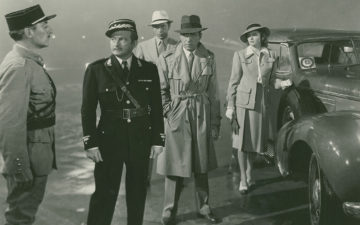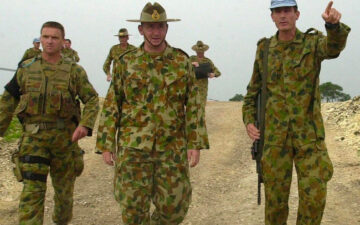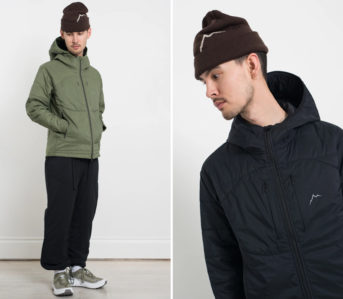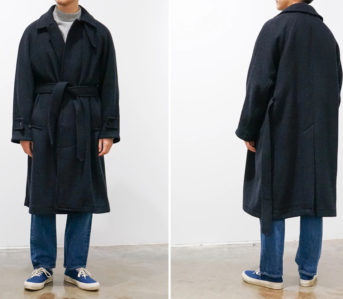A cold haze rolls into the narrow valley, engulfing the bare armatures of dormant trees in its path. It’s Winter in southwest Virginia. A lone figure unpacks the trunk and rear seat of his car —a virtual photography and recording studio on wheels —as the rising moon chases the black shadows of the treetops. Sprawling before this wool-clad man and his assistants is a double set of railroad tracks. With the equipment set up, a quick read of his watch confirms his timeliness. Studio lights, as bright as arc lamps, are switched on and shine to their full white-hot intensity while illuminating puffs of breath in the cold night air.
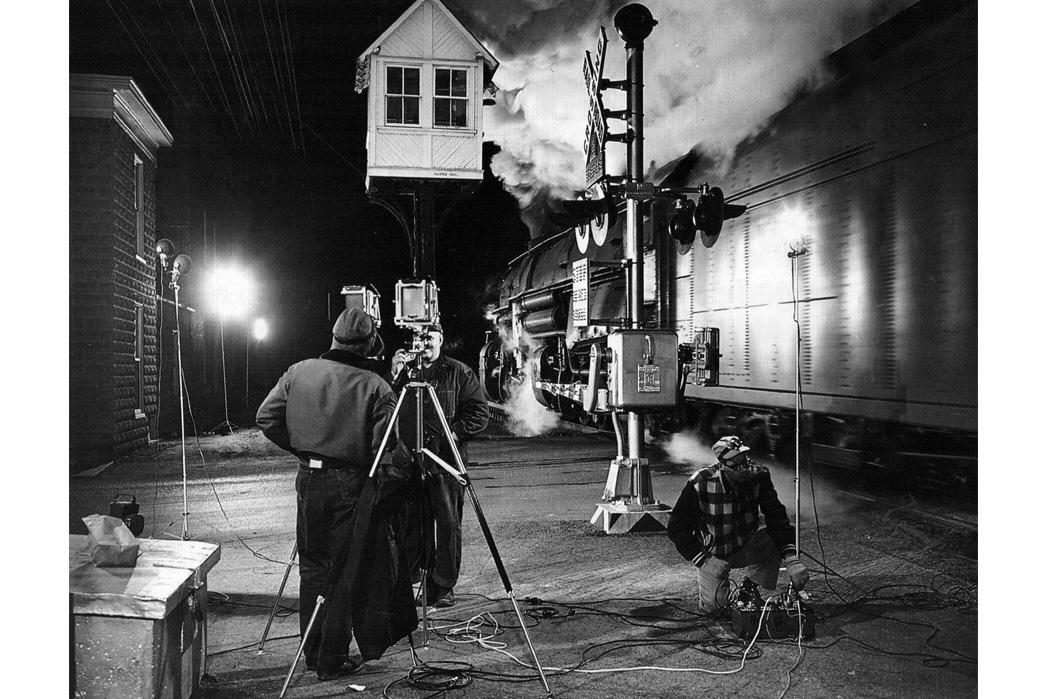
The artist and his assistants taking night shots. Image via National Parks At Night.
As though on cue from a film director, a shrill whistle blast echoes from behind the distant stone mountainside. Its high-pitched wail carries in everyone’s ears for moments afterward as the devices are readied. Steel rails rattle as if made from tin while the snaking train lumbers its way up the steep grade toward the vantage point. A column of smoke belches skywards from the massive locomotive which mixes it with billowing white steam which catches the studio lights. From the man’s perch, flashbulbs pulse and the reels of tape unspool onto more reels. These are the final pages of American steam railroading being written. A Brooklynite named O. Winston Link would capture some of the last images of the workers who tamed steam-powered giants. The railroad industry, and its effect on American workwear, would change dramatically over the following decade.
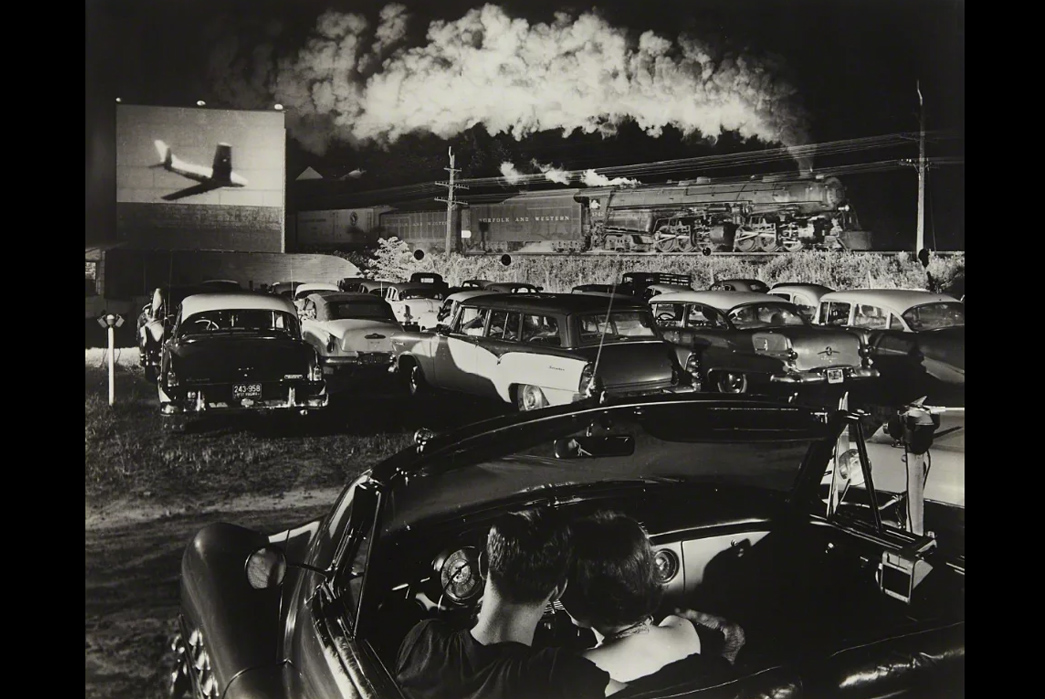
O. Winston Link’s 1956 magnum opus “Hotshot Eastbound.” Image via O. Winston Link/Artsy.net.
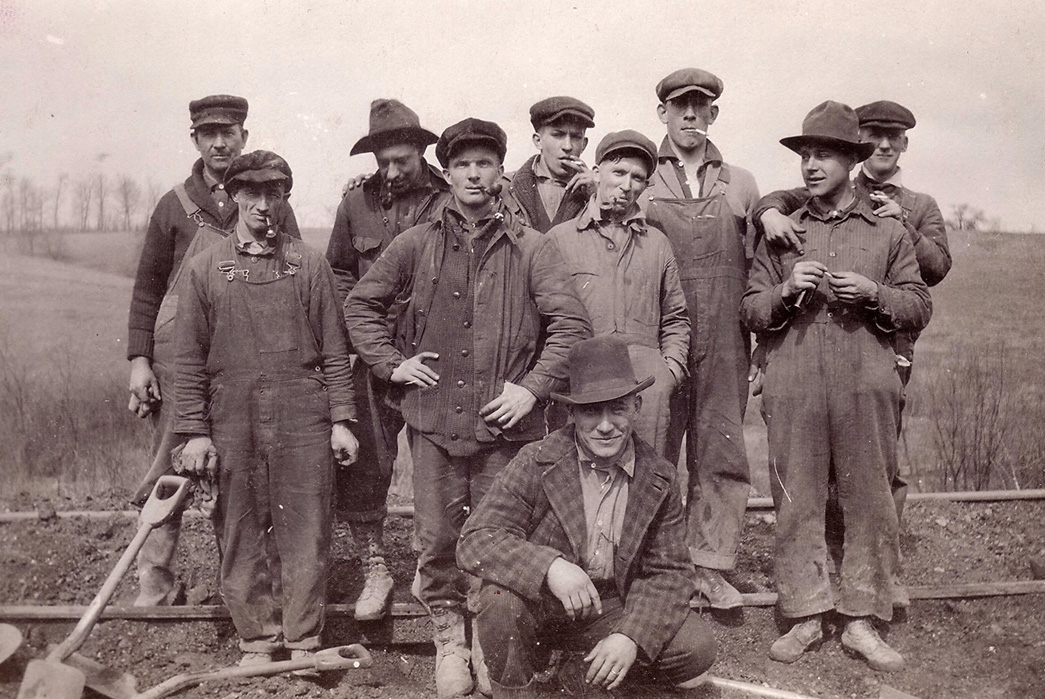
A group of railroad workers, perhaps a track “section gang,” pose with tools circa 1920. There is an astounding variety of workwear to be seen, from coveralls to overalls. Image via paws22/Flickr.
Dieselization
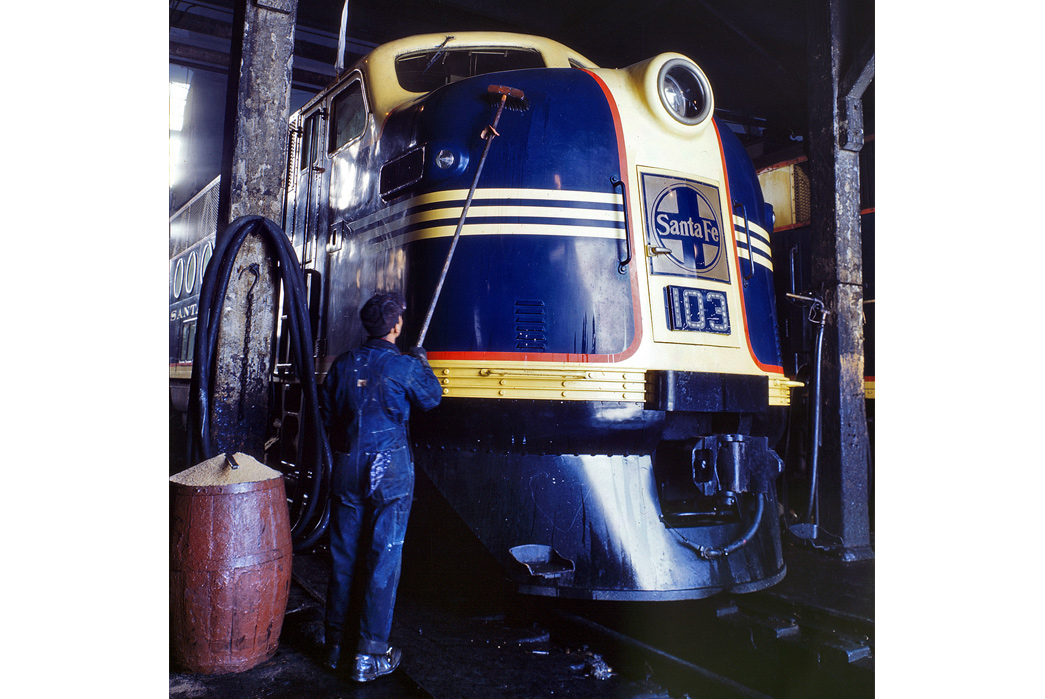
Wiping the front of a new diesel-electric locomotive, 1943. Image via Jack Delano.
Diesel-electric locomotives shifted the paradigm in the 20th century, replacing their steam counterparts en masse during the 1940s and ’50s. Powered by internal combustion engines which drove powerful electrical generators, this technology proved to be cleaner and posed fewer maintenance issues than steam power. Crews were no longer subjected to the rigors of constantly oiling and greasing a massive steel beast and satiating its appetite for coal or fuel oil. As a result, railroad workwear slowly reverted to streetwear which can be seen today. Select garments and uniforms stuck around in passenger service but modern railroaders hardly resemble the steam-era workforce.
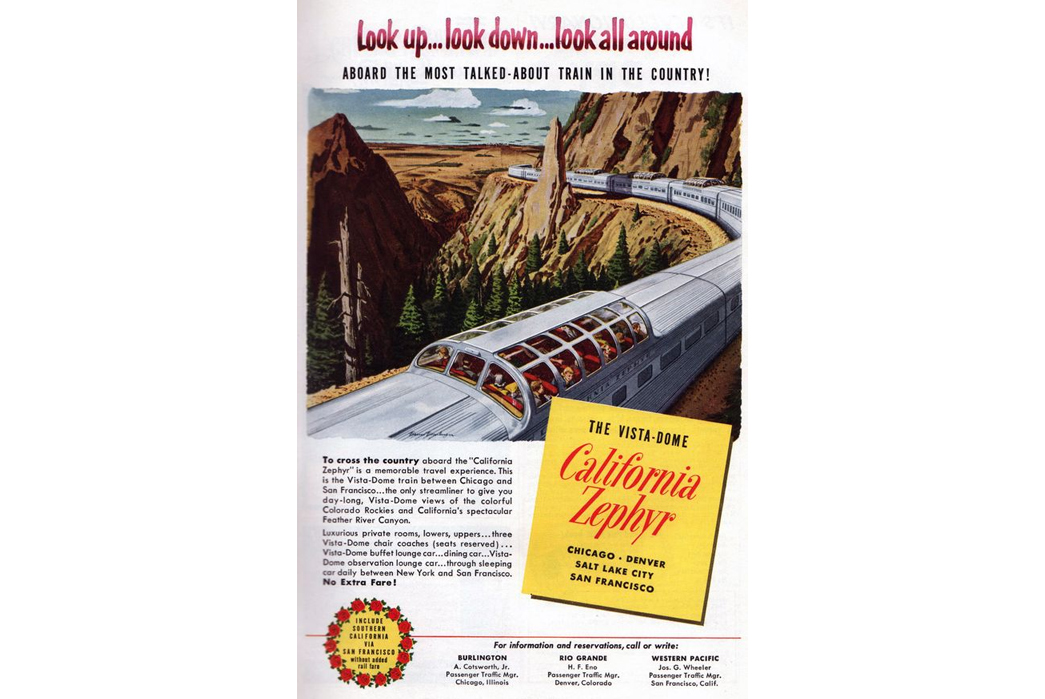
Dome cars helped promote the splendor of rail travel starting in 1945. Image via American-rails Pinterest.
The postwar years also saw the “golden age” of passenger rail. During this transitional period from steam to diesel, rail companies promoted modern luxuries aboard their trains which already boasted romantic names — “The Silver Meteor” and “The California Zephyr” being among several key examples. This kept railroading at the forefront of the American imagination and its newfound appetite for leisure and travel. The popular image of the denim-clad train crew trimmed in blue-and-white stripes would endure for another generation.
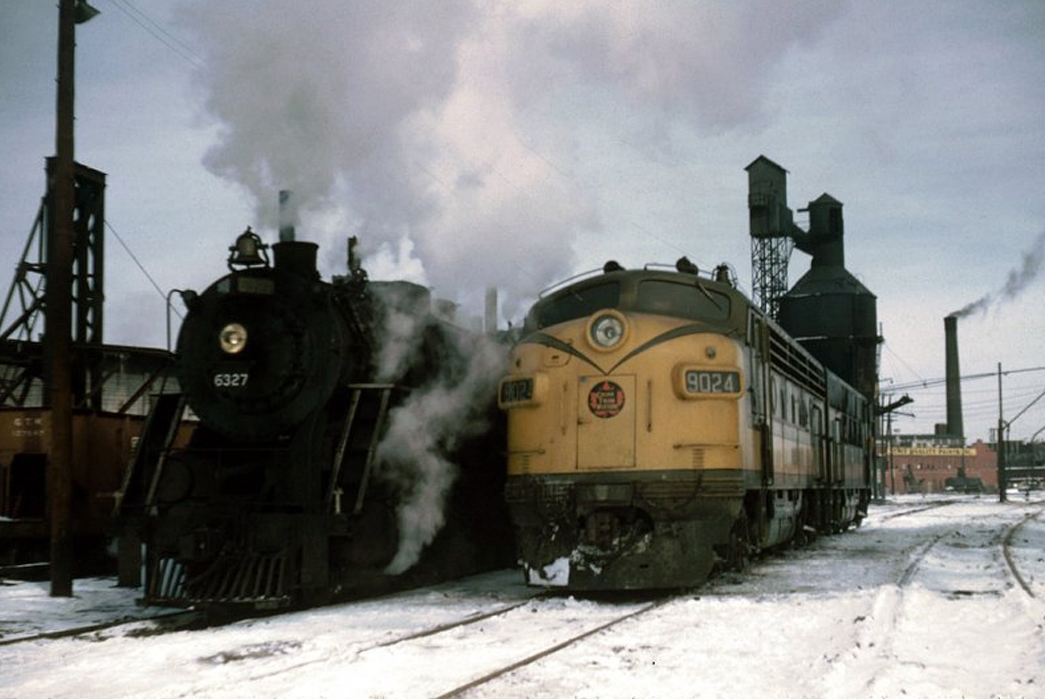
The changing of the guard in 1960. On the left, a steam locomotive is in its twilight as diesel-electrics reign. Image via Richard Beale.
Grease and Grime
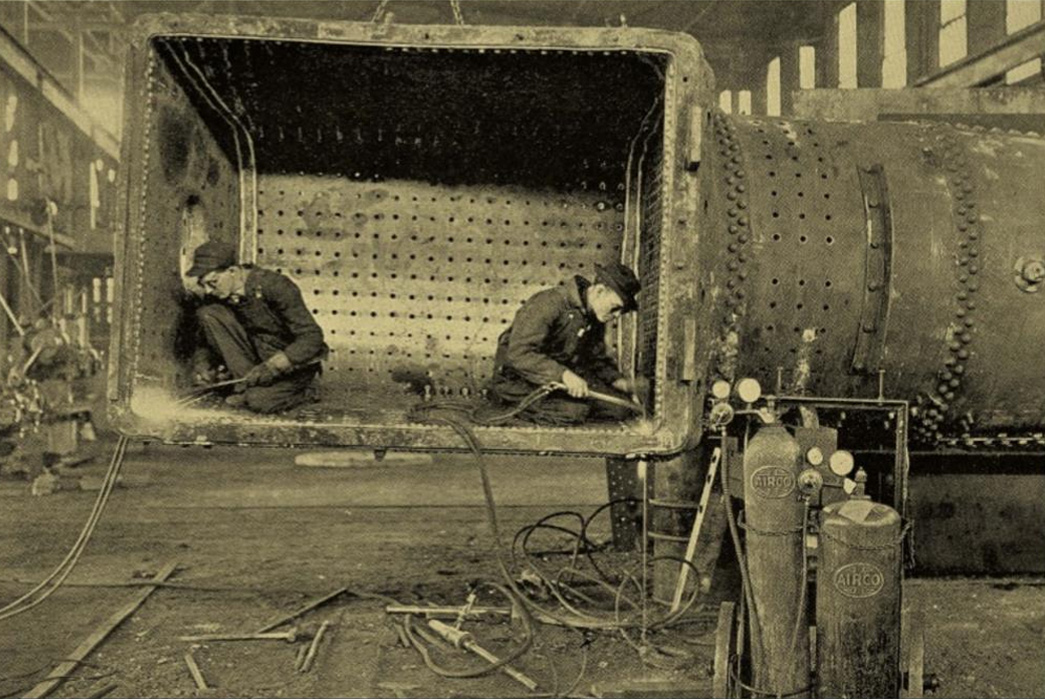
A cross-sectional view–workmen gas welding inside of a disassembled steam locomotive “firebox.” This part of the locomotive is where fuel is burned to generate steam. Image via Z. P. Liollio.
As hinted in the previous installment, boilersuits morphed into the legendary coveralls that we know today. These garments, which are essentially a waist overall and jacket sewn together, are a direct impact of the steam era on American fashion. Working in a boiler is not glamorous work — Think about a chimney sweep, but crawling on their hands and knees through a steel tube.
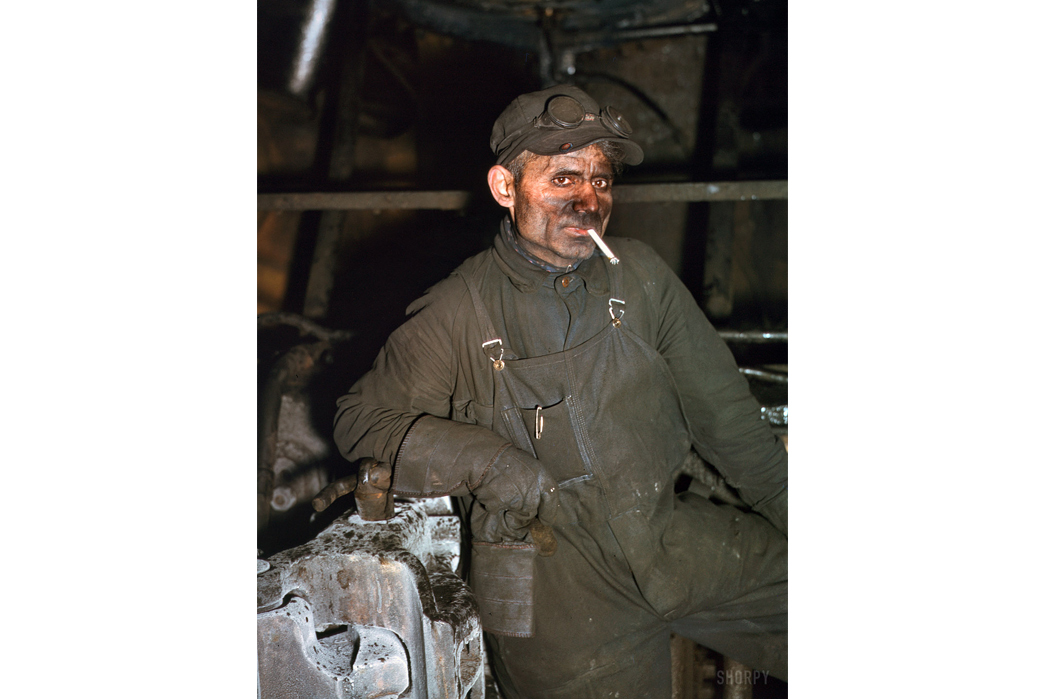
William London, a railroad worker of 25 years. Image via Jack Delano/Shorpy.com.
Also consider the locomotive “fireman,” who feeds the locomotive with fuel to generate steam. In many cases, this involved flinging shovel-loads of coal. Soot and ash find seem to be attracted to clean clothing as hair collects the cinders. Thus, a special garment was needed to keep its wearer encapsulated with moving about freely. Pioneering garment makers were working on solutions by the early 20th century, but one particular company has left an indelible legacy.
Union-Alls
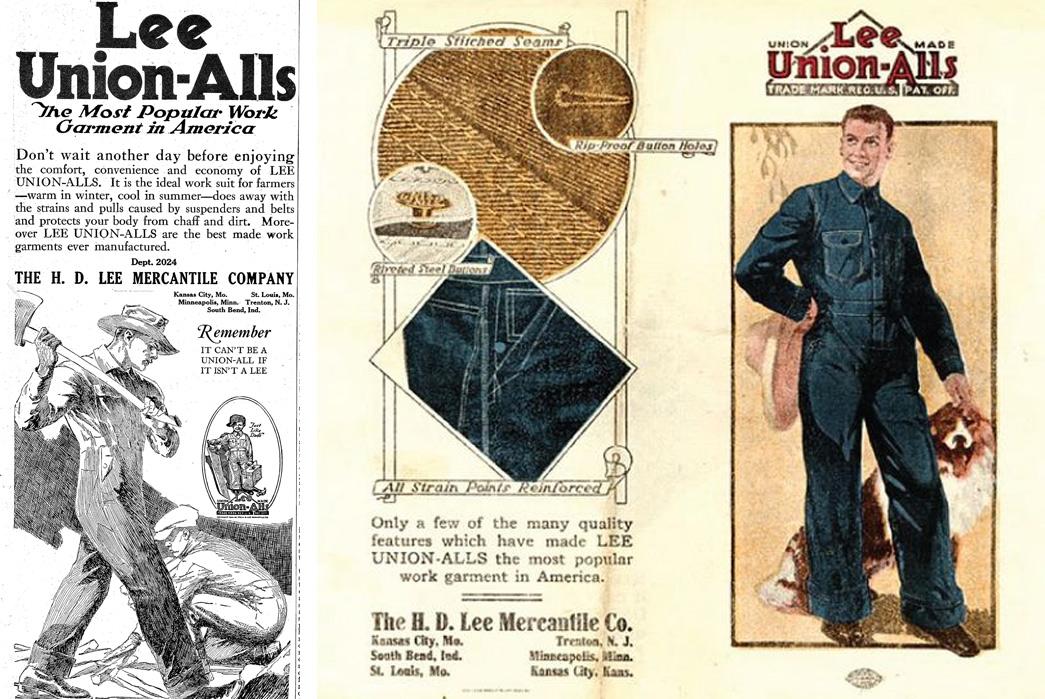
Vintage advertisements for Union-All(s). Image via Wikipedia.
Henry David Lee had made a fortune by the time he reached his thirties. Suffering from tuberculosis, he moved to the drier climate of Salina, Kansas, and began a dry goods business in 1889. Salina was an important node on the railroad line as it was situated between the hub cities of Kansas City and Denver. The H.D. Lee Mercantile Company boomed, and in 1912, the savvy businessman opened a garment factory to expand his product line. The legendary Lee brand burst onto the market in a big way. The following year, the Union-All was introduced to the world and railroaders were eager to adopt them. Coveralls or “worksuits” rapidly became entwined with American workwear and fashion.
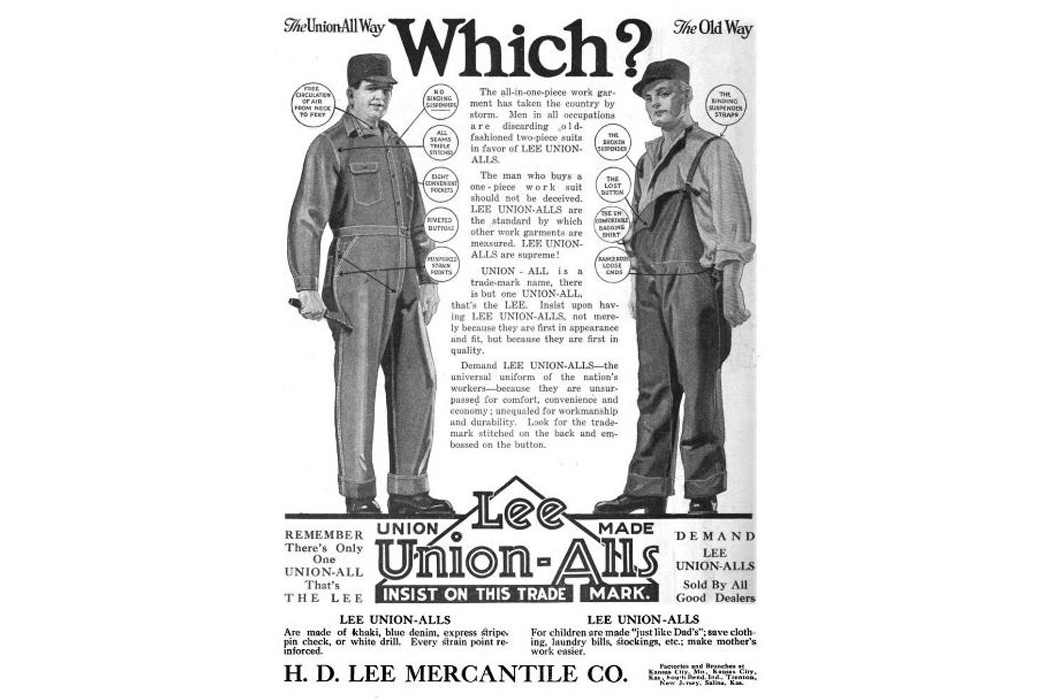
H. D. Lee was keen to highlight the advantages of Union-Alls over traditional overalls. Image via Lamoka Ledger.
A World In Flux
As in the American Civil War, railroaders played key roles in multiple international conflicts. On the distant battlefields and at the homefront, workwear manufacturers had to adapt to meet their needs. Unprecedented demand helped many makers to continue production despite widespread economic hardships.
The Mexican Revolution
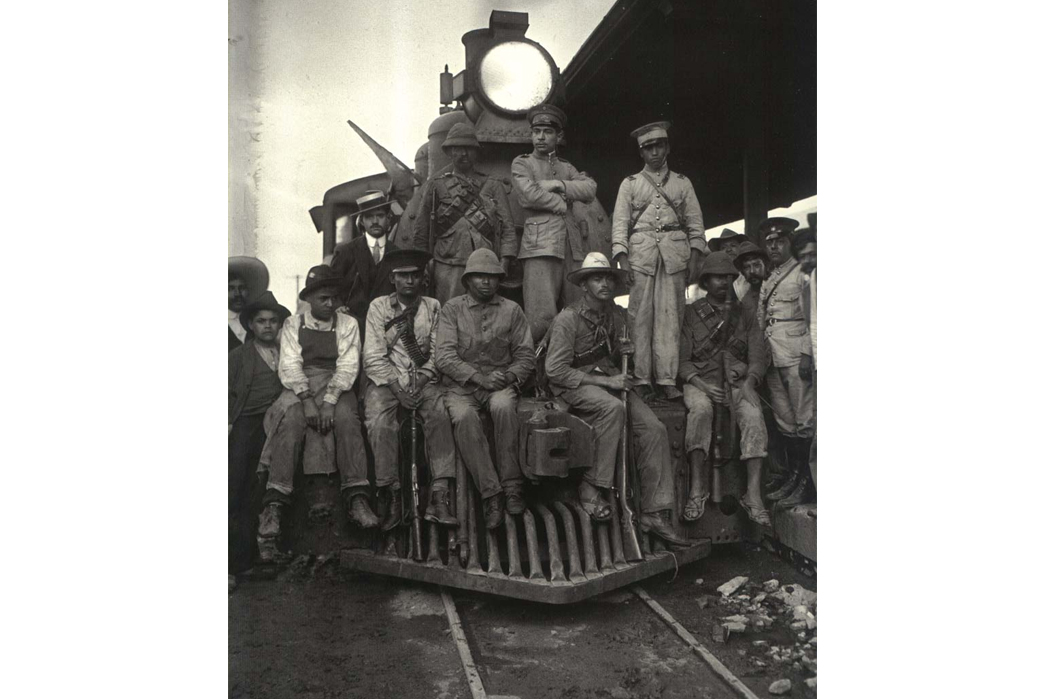
Mexican workers and soldiers intermingle in front of a locomotive. Image via Huarache Blog.
Before the U.S. entered World War I, this conflict spilled over the border sparking a military response. The Mexican Revolution was a multi-faceted struggle that lasted from about 1910 to 1920. Mexican railroaders were caught in the crossfire and performed vital missions on all sides as dramatic images of armored trains and workmen ready with weapons fascinated the public at large. In Mexico, the common peasant and worker became symbols of anti-government authority. For the American military, this conflict was just a small taste of what was to come in Europe.
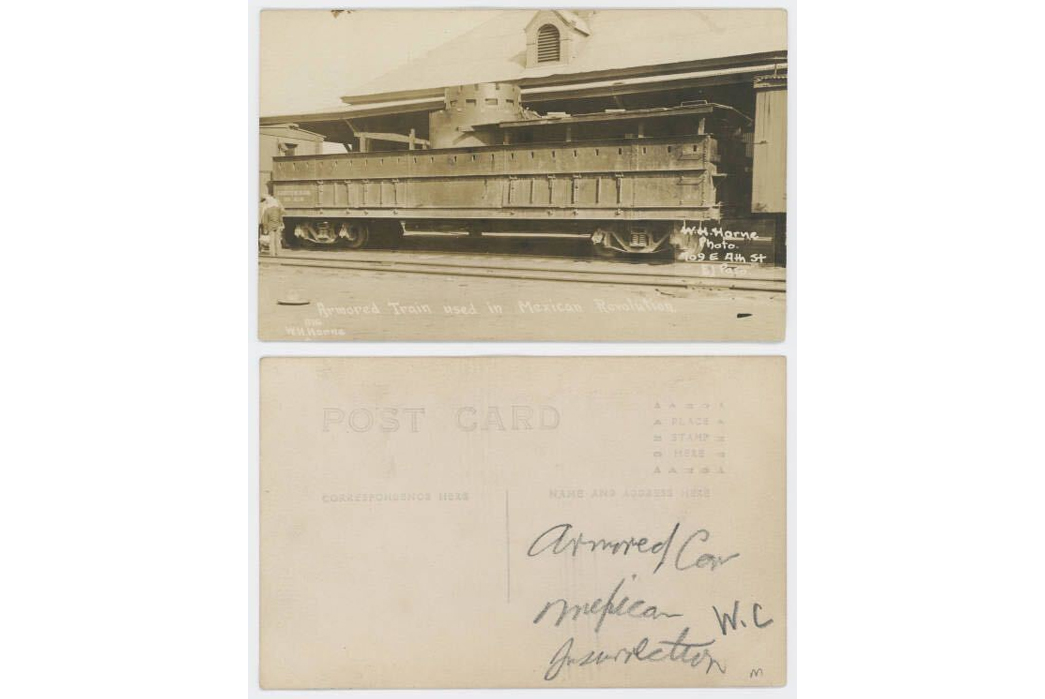
A real-photo postcard (RPPC) of an armored railcar used during the Mexican Revolution. Image via SMU Libraries.
World War I
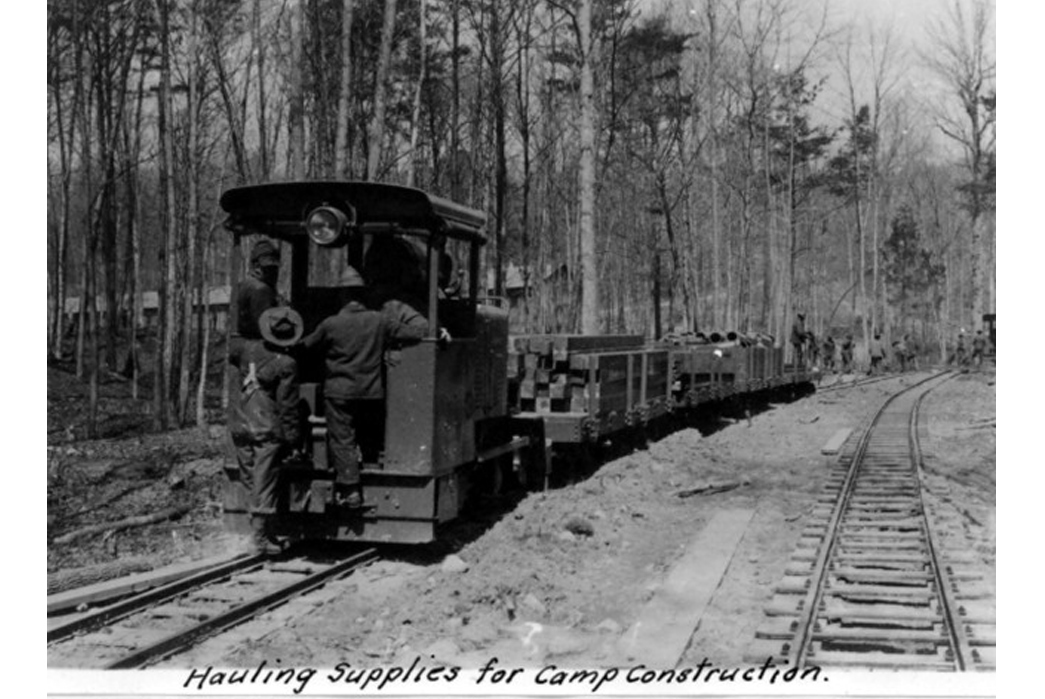
American soldiers operating a “light” locomotive, ca. 1918. Image via U.S. Army.
The Allied and Central Powers spent the entire war building resilient supply lines along the Western Front. Besides the conventional railways, a network of narrow-gauge light railways — dubbed “trench railways” — abutted the trenches immediately behind the front lines. These trains were used for moving ammunition, men, and supplies. An early adoption of diesel locomotives is seen here, the plume of smoke generated by burning coal attracted enemy attention.
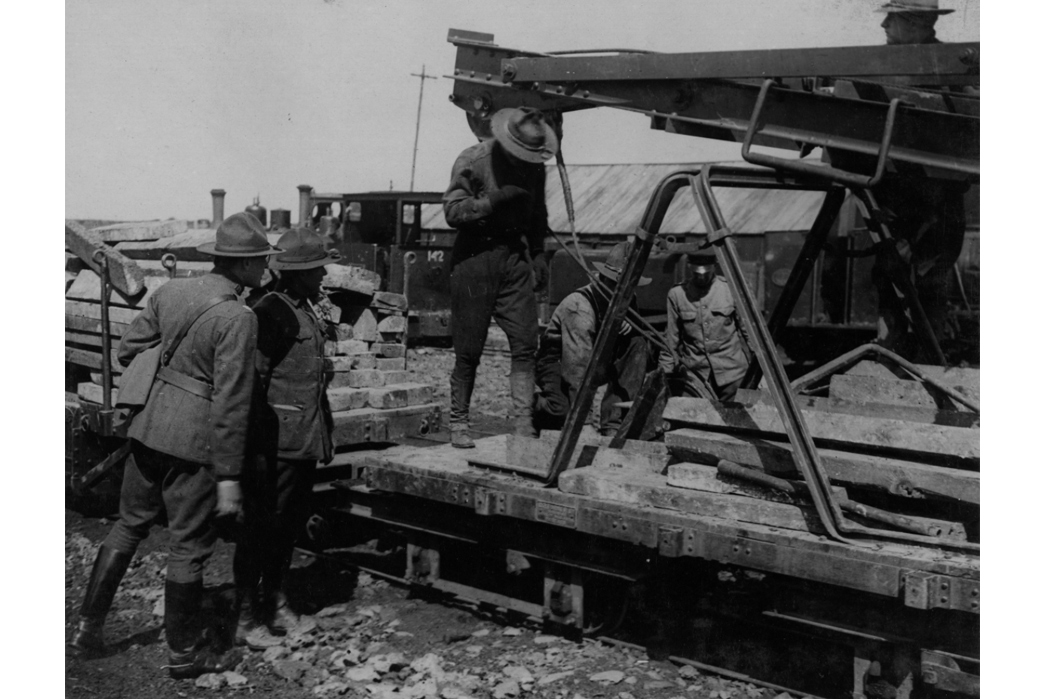
A group of soldiers from the 11th Engineers (U.S.A.) working near Cambrai, 1917. This unit was the first American element to see action on the Western Front. Image via The National Archives.
After the U.S. entered WWI, railroad engineers were some of the first American soldiers to see combat. While the flood of fresh troops continued from 1917 into 1918, a major problem arose; the U.S. Army didn’t have enough workwear! A relatively small fraction of troops would actually fight the enemy, it was logistics and communications that required extraordinary manpower. Case in point, the U.S. took a major part in running entire railways in the north of France. Enterprising officers were forced to purchase wholesale from civilian catalogs to fill their needs and even local French manufacturers were tapped. By the time of the Armistice in November 1918, American railroaders overseas wore a hodgepodge of government-issued denims (some blue, but predominantly brown near the front), American commercial workwear, and local French products.
Women in Denim
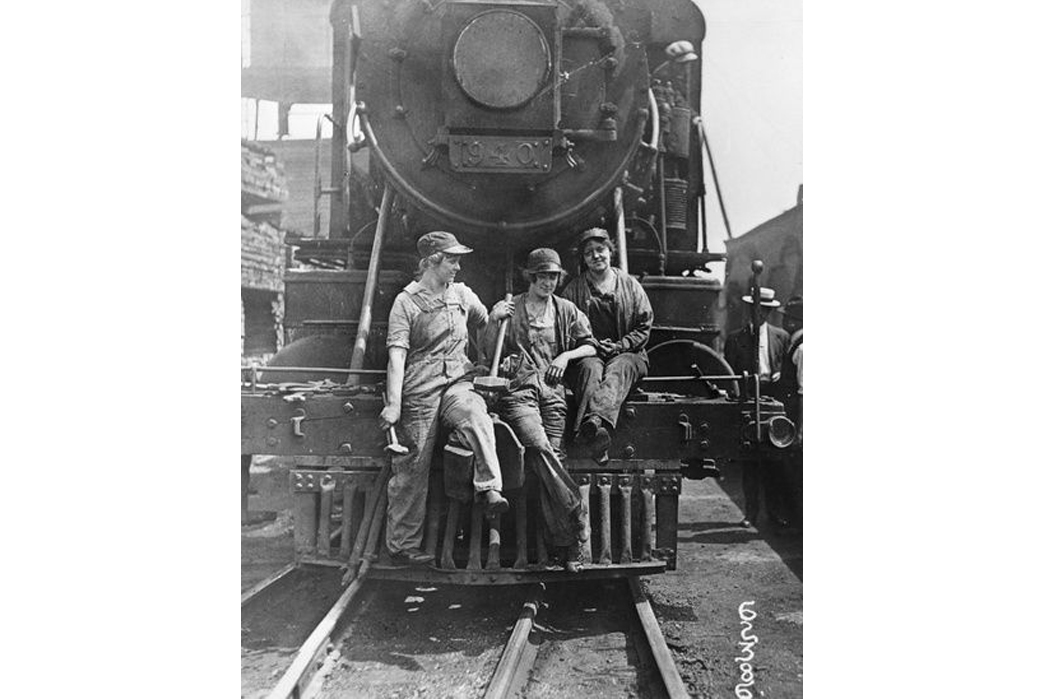
Female railroad workers in 1918–the final year of World War I. Image via Sage Sky/Pinterest.
Women also entered the workforce in droves. Draftees and volunteers left a void of unfilled positions on the railroads, and women were rushed in to fill them. From January to September 1918, the number of women employed by American railroads rose by 66%!
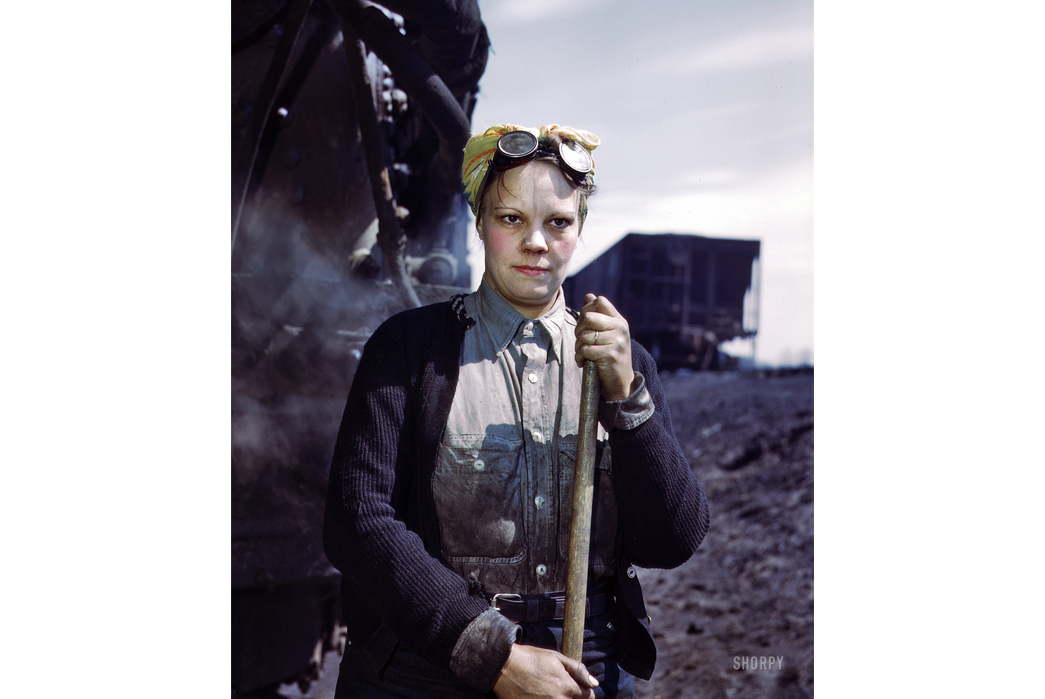
A female engine “wiper” named Irene Bracke, mother of two, pictured during World War II. Image via Jack Delano.
Mass-produced workwear now entered the female wardrobe, and would have a lasting impact on public perception. This trend was amplified by the Second World War, which embroiled an entire generation in the early 1940s. American women not only embraced the challenge but they created a romping, bandana-wearing mode that would evolve into the Rockabilly style.
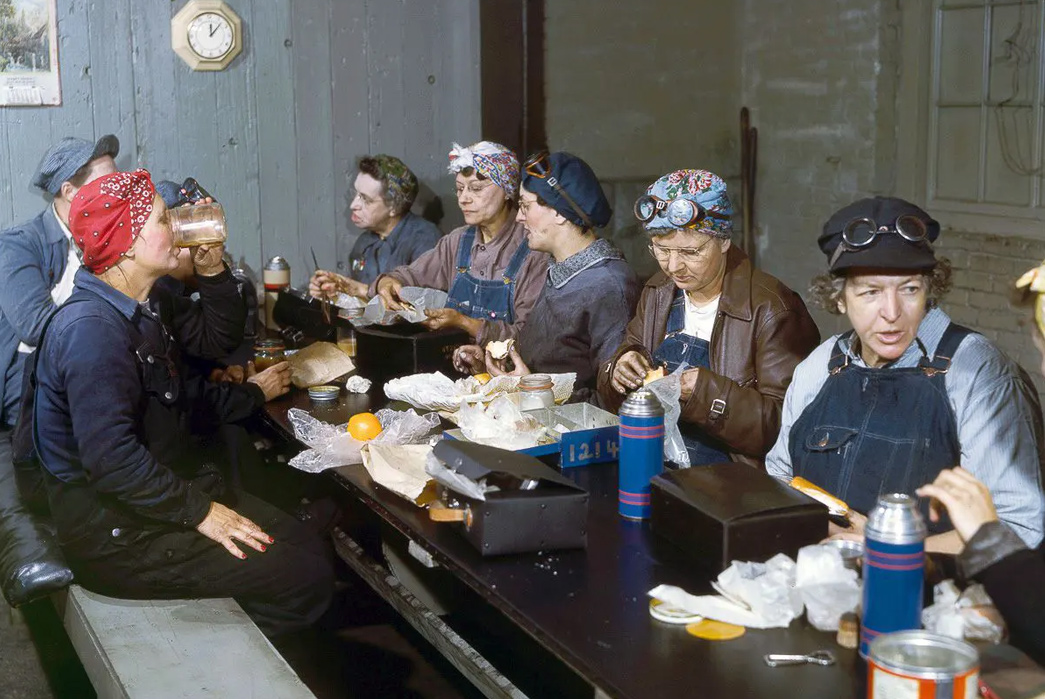
Railroad workers take a lunch break in Iowa during World War II. Image via Rare Historical Photos/Jack Delano photo.
“Hoboing”
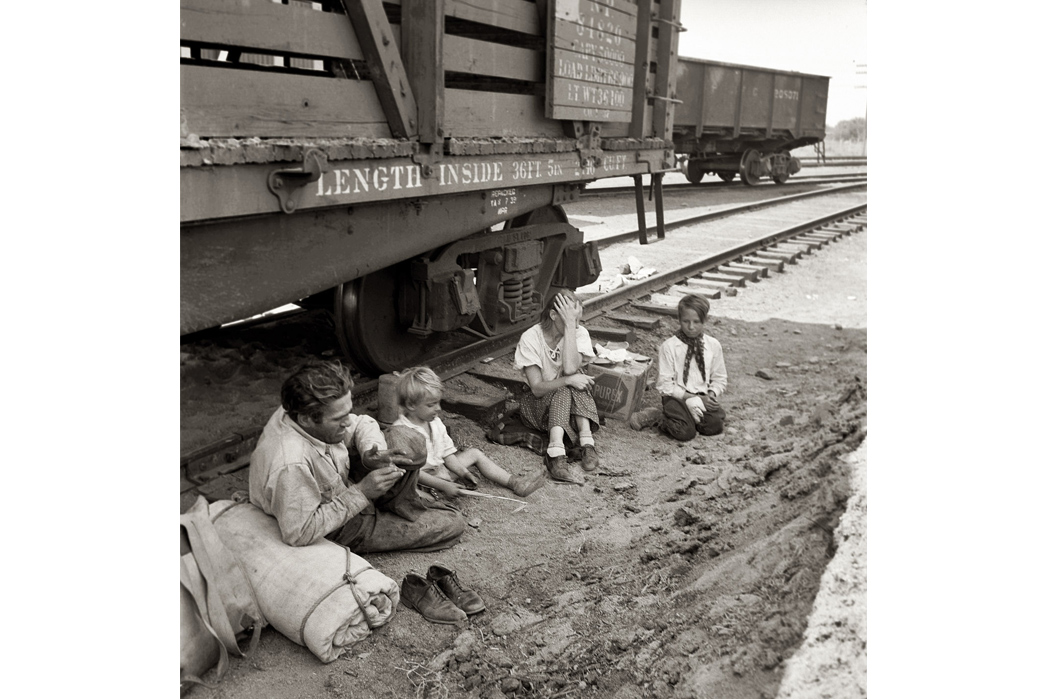
A family of agricultural migrants had traveled by freight train in Washington state, 1939. Image via Dorothea Lange.
The Great Depression (1929 – 1939) put the brakes on many industries. Desperate, homeless, and seeking adventure, droves of unemployed workers found itinerant opportunities by riding the ever-improving rails. This was done without permission, illegally. Their ranks included a large number of World War I veterans who had struggled since returning home. In American railroad lore, the hobo became a sort of folk figure. However, attitudes were mixed about “bums;” railroad management tended to drive them off while some blue-collar workers felt a fraternity with them. The railroad police forces, popularly dubbed “bulls,” were especially antagonistic towards boxcar stowaways.
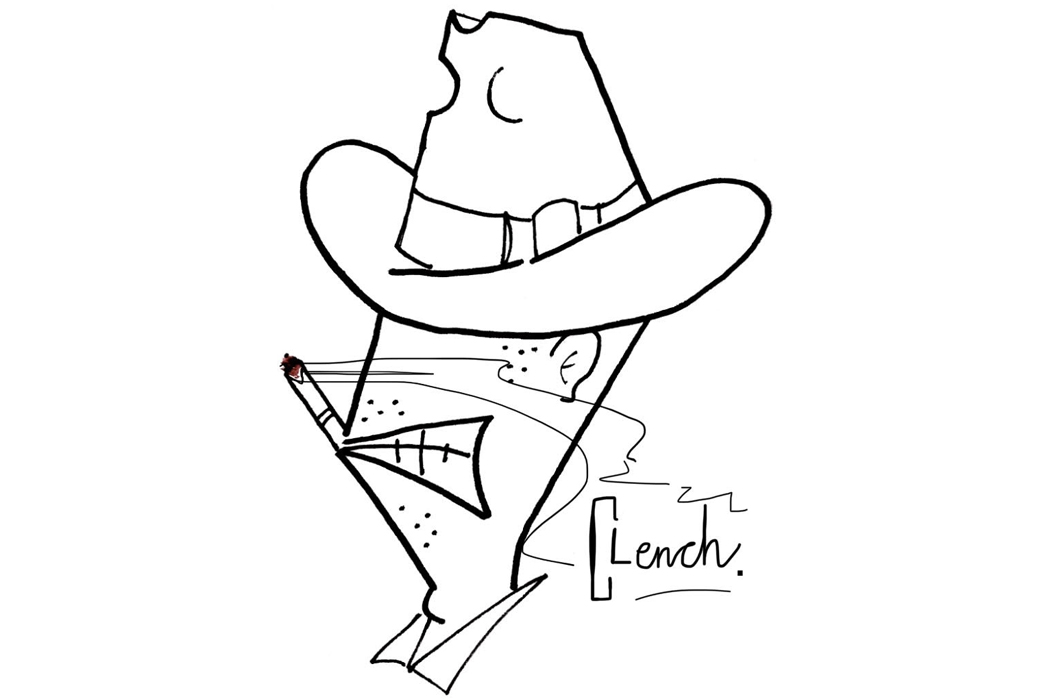
The author’s moniker, “Clench,” was inspired by a 1910s Stetson hat. Image via Z. P. Liollio.
Many hobos, and even railroad employees, adopt unique “monikers” that serve as a hallmark. These early graffiti tags decorated railroad cars with white chalk and some of them have taken on lives of their own. One particular tag, the tall-crowned cowboy hat of Bozo Texino, has attained legendary status. This creation of locomotive engineer J. H. McKinley even has a feature-length documentary named in its honor.
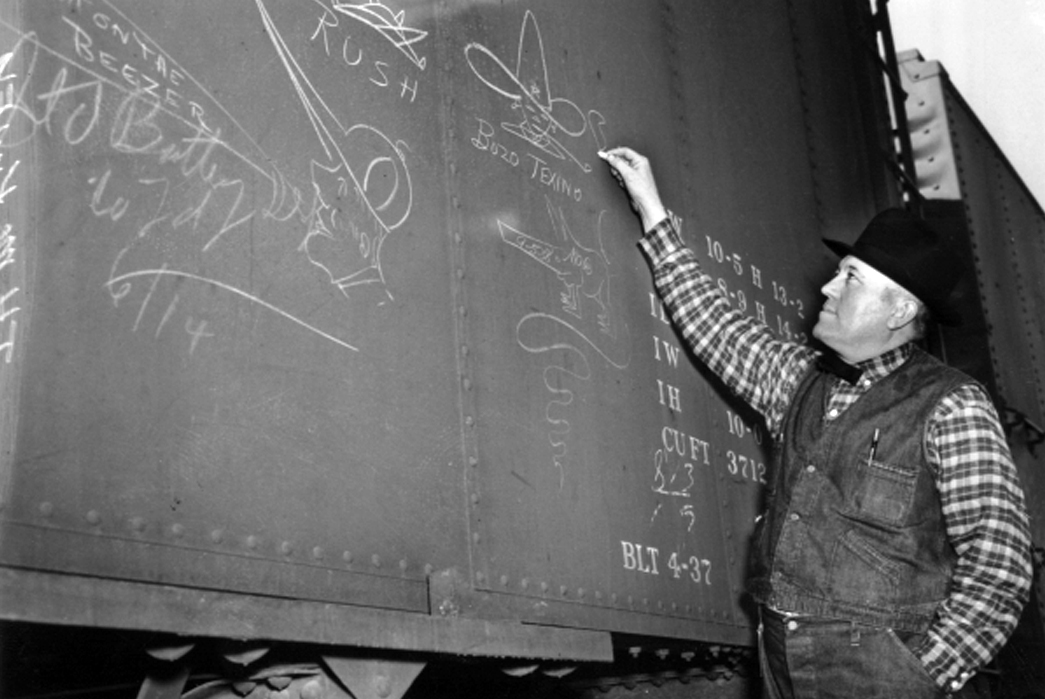
J. H. McKinley drawing Bozo Texino in a sweet denim vest. Image via Art in the Streets.
A few images of hobos persist in the public’s imagination of the “Dirty Thirties.” The red bandana bindle — a makeshift cloth bag tied to the end of a stick and carrying food and belongings — is a popular motif. Some depictions are more formally dressed, but still grungy. However, there was a large proportion who donned dungarees as evidence of their former trades. Like a modern odyssey, hoboing continues to be a lifestyle for some travelers in the present day. Resourcefulness and rugged individualism are key requisites.
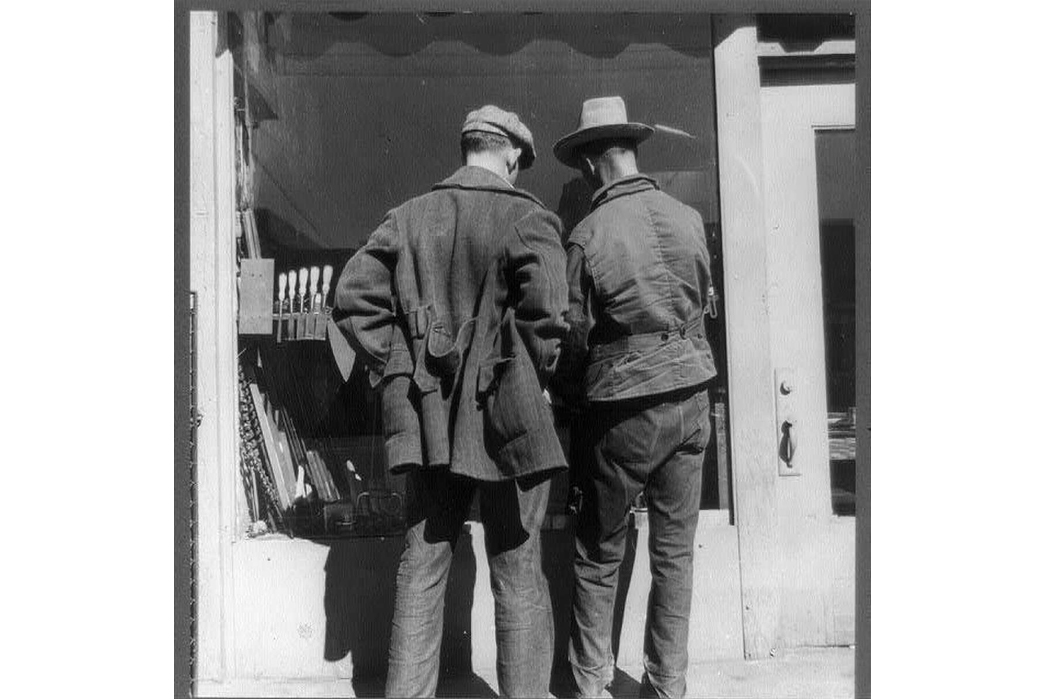
San Francisco’s “Skid Row” as photographed by Dorothea Lange in 1937. Image via Dorothea Lange/Library of Congress.
Workwear Technology Race
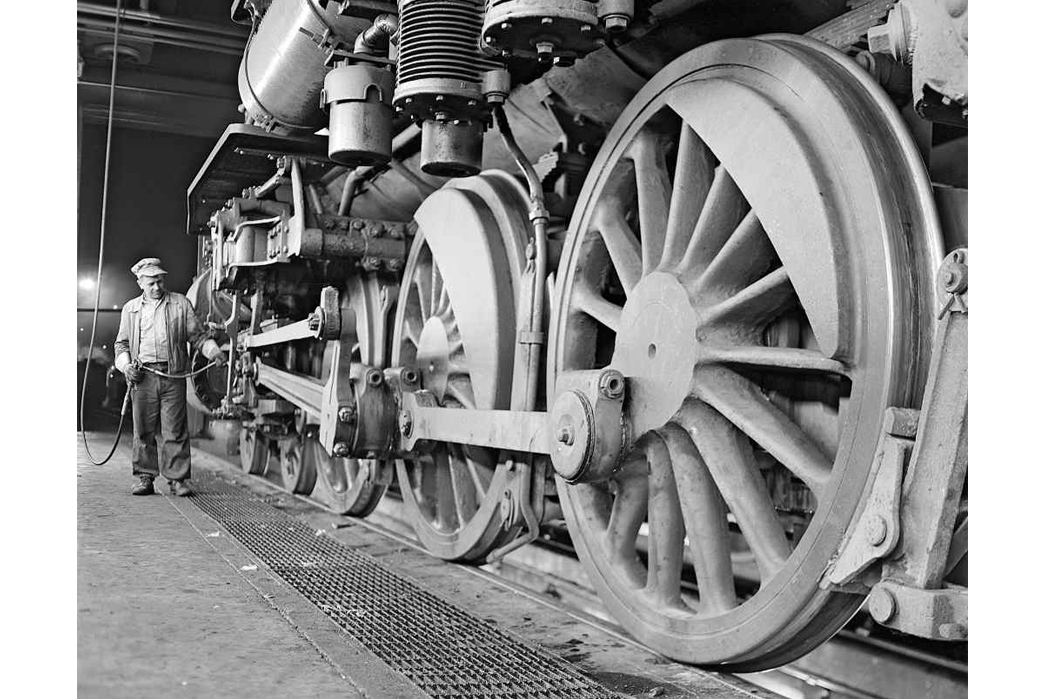
In the twilight of steam, O. Winston Link captured an image of this locomotive being serviced. Note the full-zip coat. Image via O. Winston Link/Incredible.
Safety and efficiency are key. The second quarter of the 20th century saw the rapid advance of technology like never before in history, with clothing keeping pace. Talon Zippers, universally familiar to leather jacket aficionados, began production in the 1920s and influenced the half-zip and full-zip styles of the years immediately after. Not to be shut out of the fastener market, snaps also entered the American workwear realm. The technology had existed in Germany since 1885 but arrived on American shores without the same fanfare that zippers received. The classic western shirt didn’t receive snap buttons until at least the late 1930s.
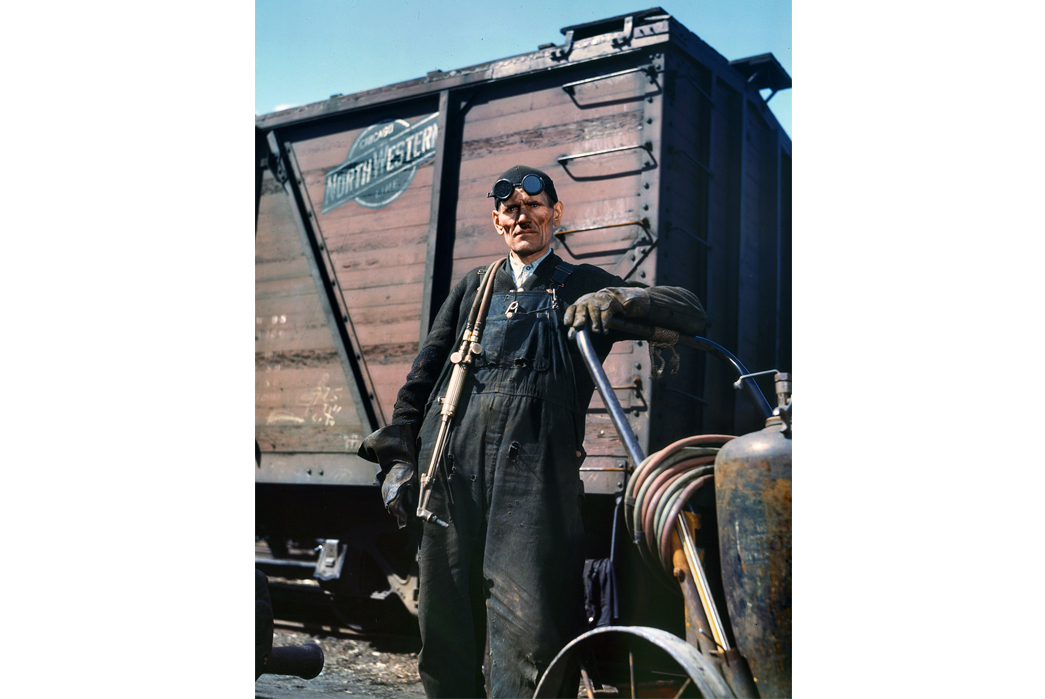
In the first half of the 20th century, welding was a relatively new trade. If any readers have insight on the collarless jacket that this man is wearing, the author would like to hear it. Also, notice the snap closure on the overalls’ bib pocket. Image via Jack Delano/Shorpy.com
From leather welding jackets to wool pullovers, all of this engineering would serve to clad the American railroad. Everlasting among these inventions is the Steel- or Safety-toe boots. These were initially military innovations. Before World War II, Red Wing Shoe Company wanted to bring this level of safety to industrial workers. Today, this type of footwear is required by most railroad companies
Engineer Boots
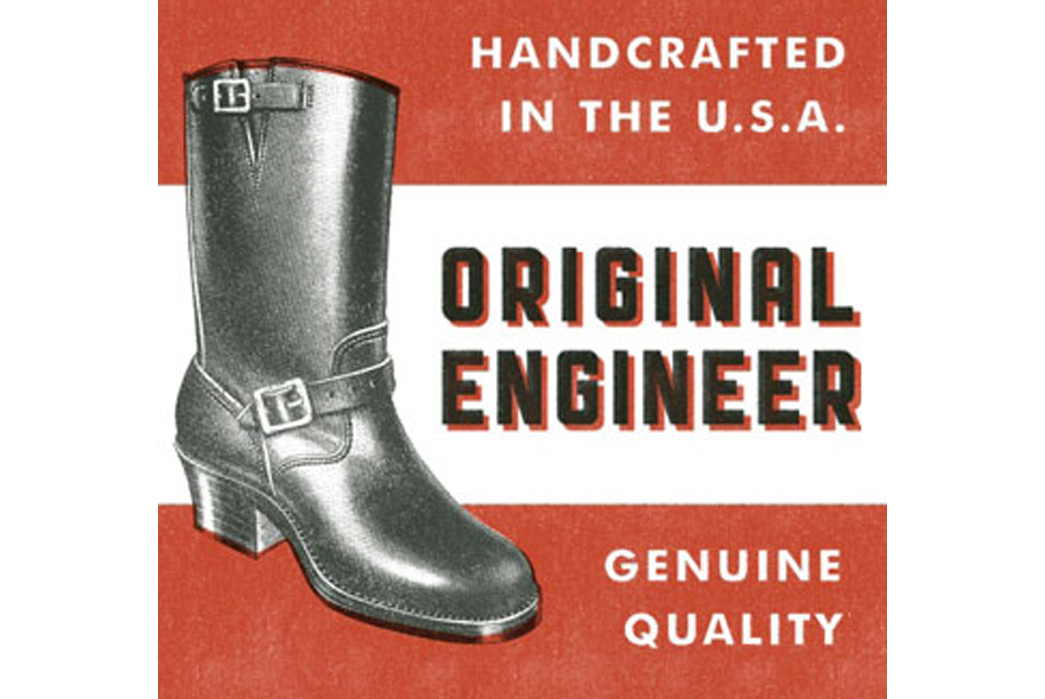
A 1943 ad for Chippewa engineer boots. Image via Michael MacRae/American Society of Mechanical Engineers.
While steel-toe boots became the modern standard, a far more radical piece of footwear emerged at about the same time – the iconic engineer boot. The unmistakable buckled-and-strapped engineer boot has its origins in English riding boots. Introduced in the 1930s as a workboot marketed to railroad firemen, this style wouldn’t see widespread popularity until after World War II. The design allowed its wearer to be free from laces that could otherwise snag on sharp metal or trap sparks and cinders. Chippewa Shoe Company and West Coast Shoe Company (Wesco) were the early promoters. Welders valued the boot’s design for the same reasons they were sold to railroaders. As motorcycle culture took off around 1950, they then became coveted by bikers who likewise had no use for laces. It was on the big screen, with motorcycling tough guys, that the engineer boot first became a pop culture icon.
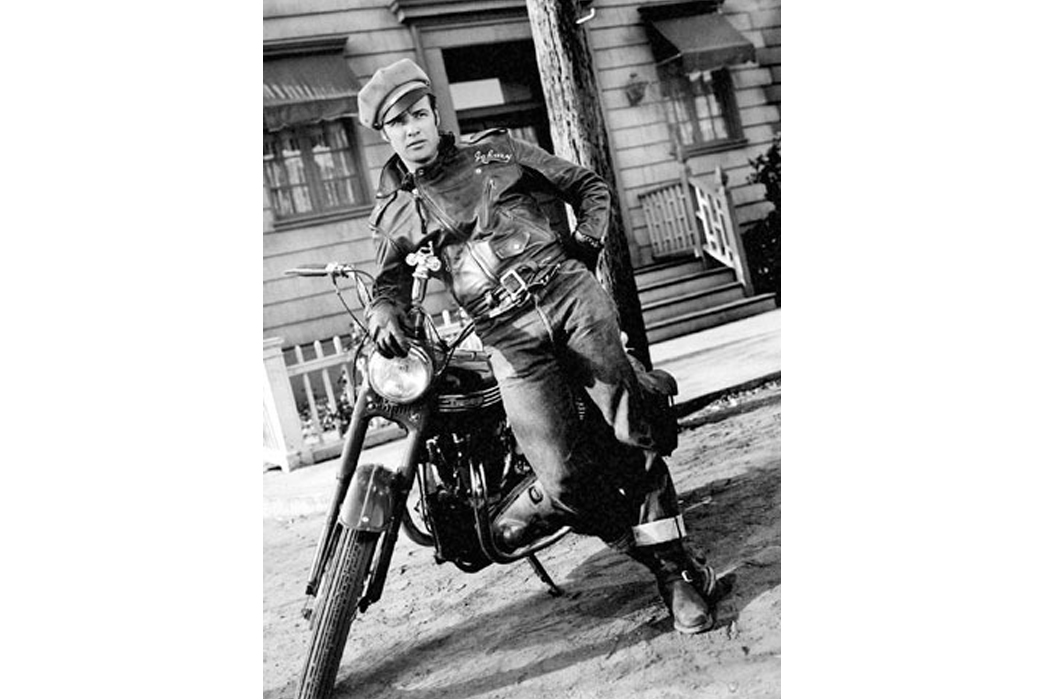
Marlon Brando in a pair of engineer boots as seen in The Wild One (1953). Image via Michael MacRae/American Society of Mechanical Engineers.
Overalls Get Overhauled
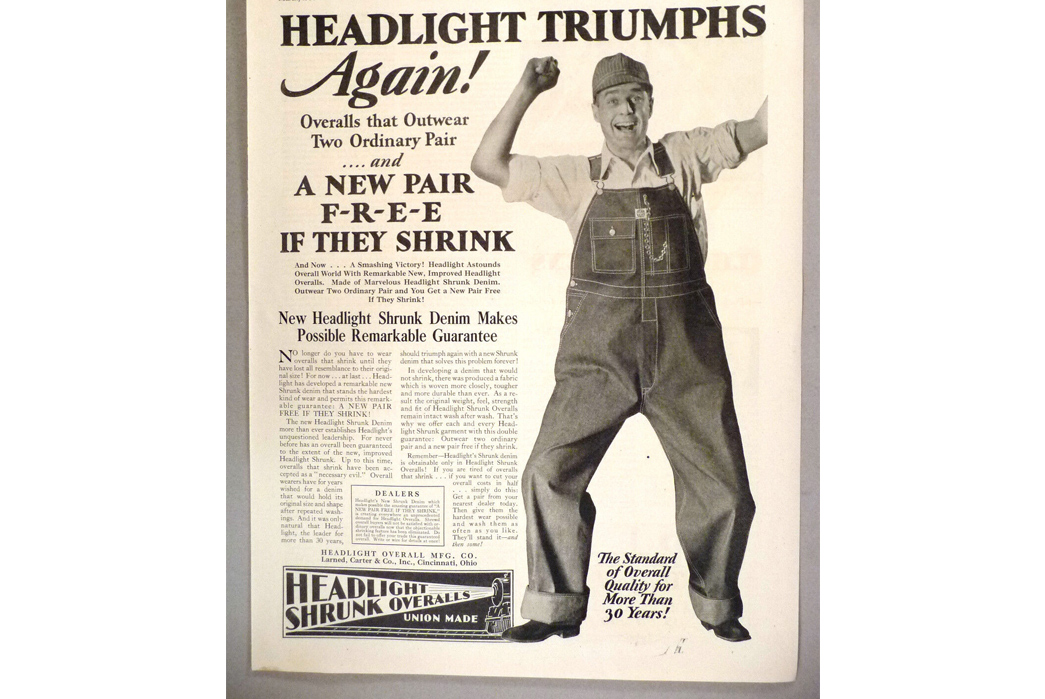
Headlight (a brand that is now licensed by Toyo Enterprise) was one of the leaders in railroad workwear during this period. A locomotive headlight beam is even in their trademark! Typical of the pre-war period, the bib pocket flap pictured above kept pace with the times. Image via avalon-collectibles/eBay.
Between 1910 and the mid-20th century, the sizes of the bib pockets on overalls generally increased. For railroaders, this turned the garment into a veritable tool belt. New pocket flaps protected the contents inside. Around World War II, snaps began to be included on pocket flaps and other closures.
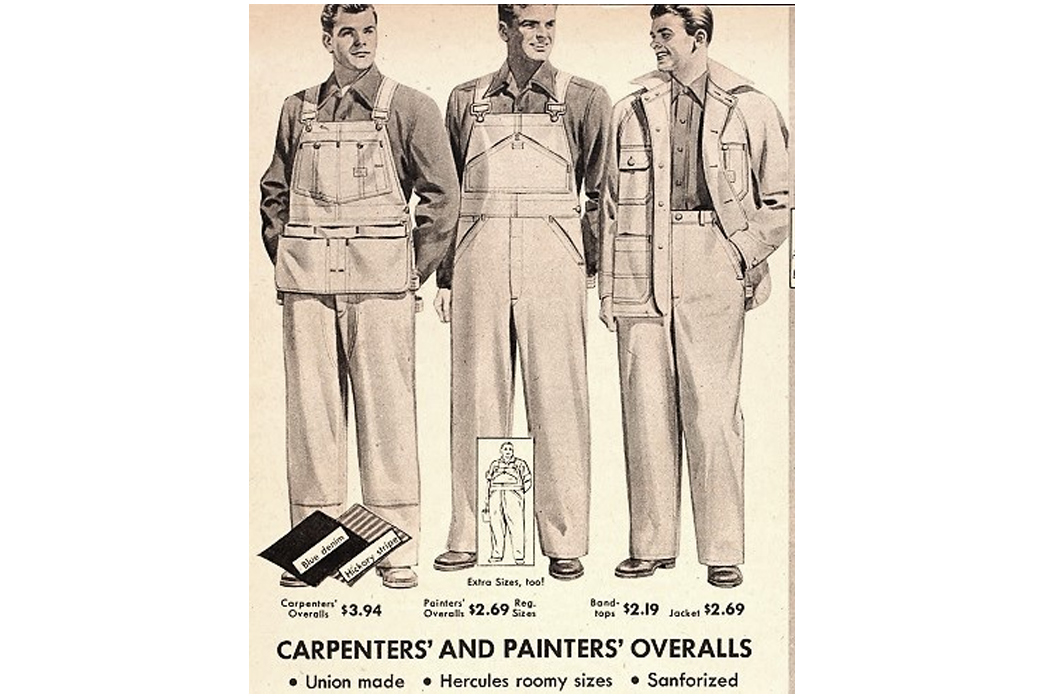
This 1950 Sears catalog offered some pocket-happy selections. Image via witness2fashion.
The Thompson Chore Coat
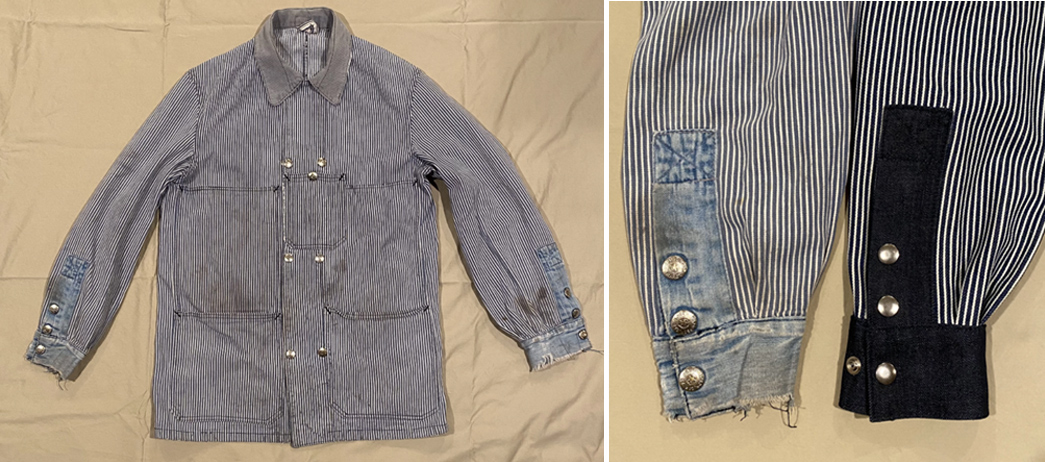
On the left is an original Thompson Chore Coat attributed to the New Haven Railroad. On the right, is a comparison between the original’s sleeve and a prototype of a reproduction. Images via Chris LaRose.
Crafted by the Thompson Manufacturing Company in the 1940s, few garments capture the spirit of garment technology better than this chore coat. Train crews of the New Haven Railroad were one known group of wearers. Headquartered in Belfast, Maine, they may have supplied other local railroads as well. Indigo denim cuff trim and a blue corduroy collar observe the ornate qualities that are reminiscent of a military uniform.
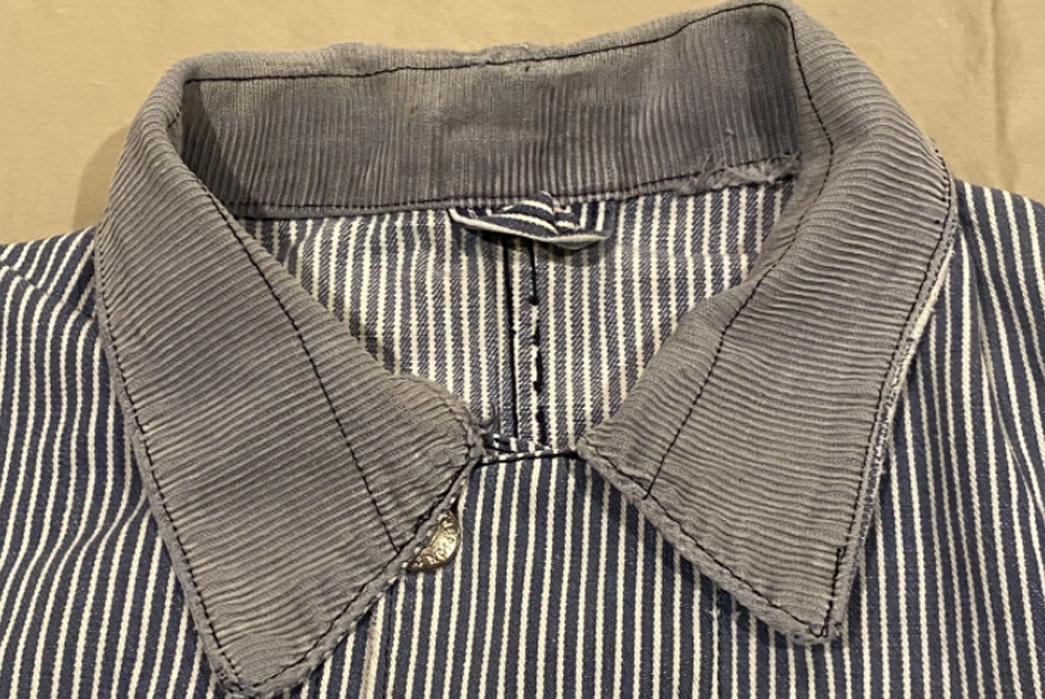
Collar detail. Image via Chris LaRose.
The double-breasted snap fasteners place the below garment solidly around World War II as this type of fastener gained traction in the U.S. The pockets have also been arranged in a way that maximizes storage, specific functions, and access (which are also quasi-military aspects). Despite its cutting-edge features, there is an ode to American railroading tradition; the body and sleeves are cut from blue-and-white striped “hickory cloth.” As a fashion piece, it impressed upon the public the idea of uniformity and professionalism in the industry.
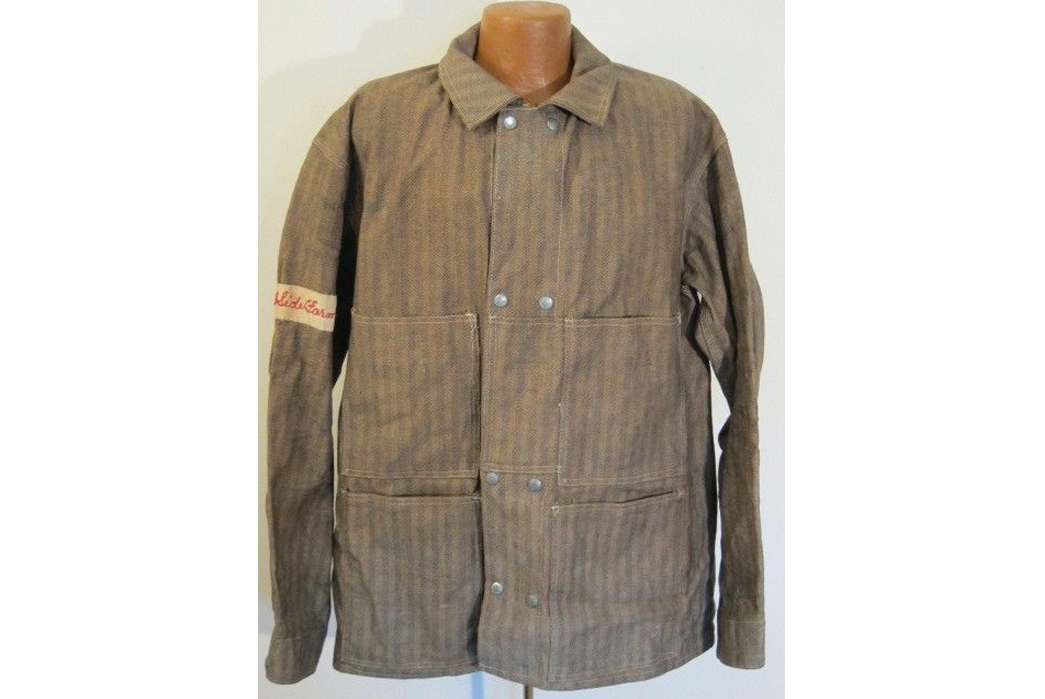
A version of the Thompson Chore Coat pattern cut from herringbone twill. Image via TheDenimIndustry.
Engineer Jacket
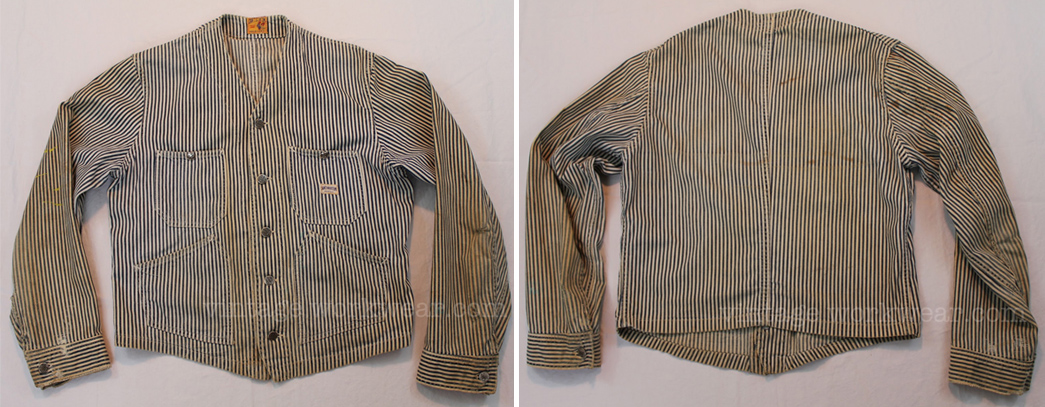
An excellent example of a purpose-built railroad garment that later became fashionable. Images via vintageworkwear.com.
This pattern is often attributed to the second quarter of the 20th century, which seems to have been an inventive time for outerwear. It can be described as a “vest jacket” that is especially suited to working inside a locomotive cab. No collar means no coarse fabric rubbing against the neck. Made by Can’t Bust ‘Em, the “express stripe” denim example pictured is rarer than the more common hickory stripe fabric.
DayGlo
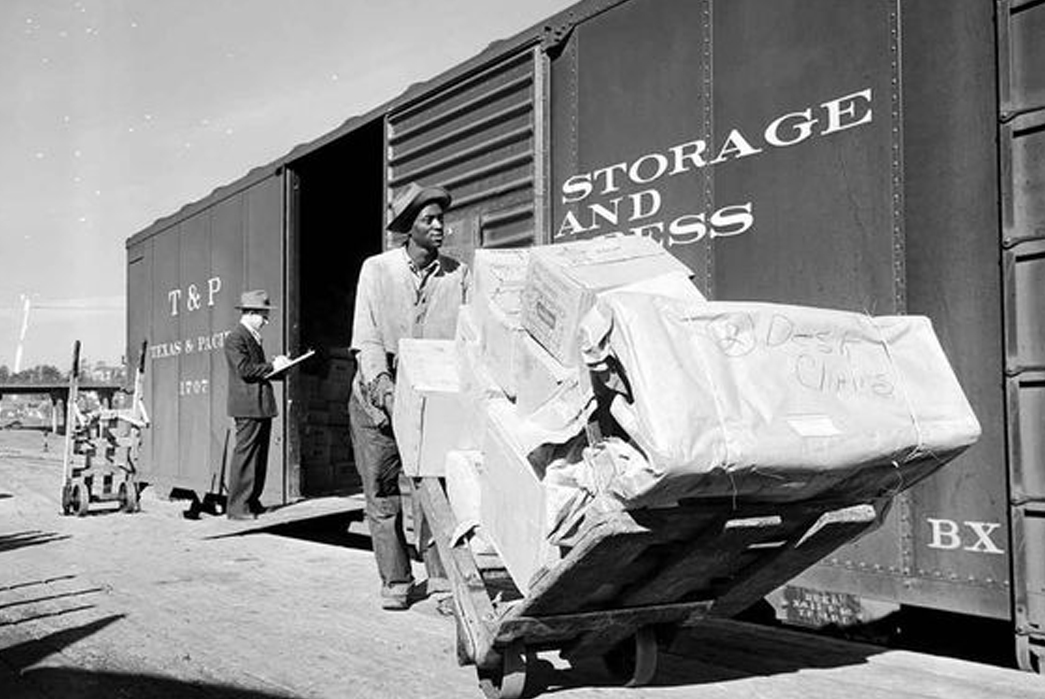
Unloading a boxcar in 1946. It was in a similar setting that Bob Switzer suffered the injury which eventually led him to research fluorescent pigments. Image via June Coker.
As with steel-toe boots, retroreflective safety vests are standard on modern railroads. While not mandated by U.S. law, the large railroads require that they be worn as a policy. Reflective clothing has its origins in an accident that occurred while unloading freight from a boxcar. In 1933, Bob Switzer was moving crates of tomatoes from the railcar when he suffered a serious fall. Doctors had him sit in a dark room over the course of several months to help heal his vision. During this period, he formulated an idea with his brother Joseph; glow-in-the-dark paint pigments. World War II saw the widespread use of the brothers’ work on everything from aircraft and ground vehicles to ships.
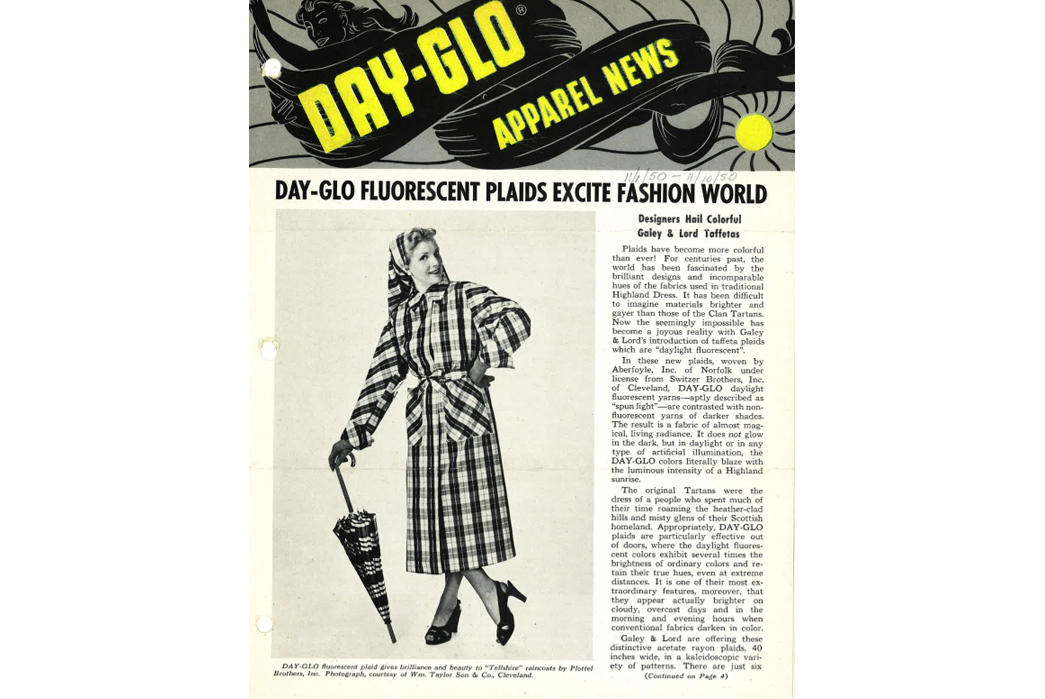
DayGlo plaids were marketed as vogue in 1950. Image via DayGlo.
Bob would prototype the first piece of high-visibility clothing by dying his wife’s wedding dress with DayGlo pigments. By the 1960s, “high-vis” vests as workwear were beginning to enter the market. Even the “hippie” counterculture appreciated the vibrant, almost psychedelic pigments produced by DayGlo Color Corporation.
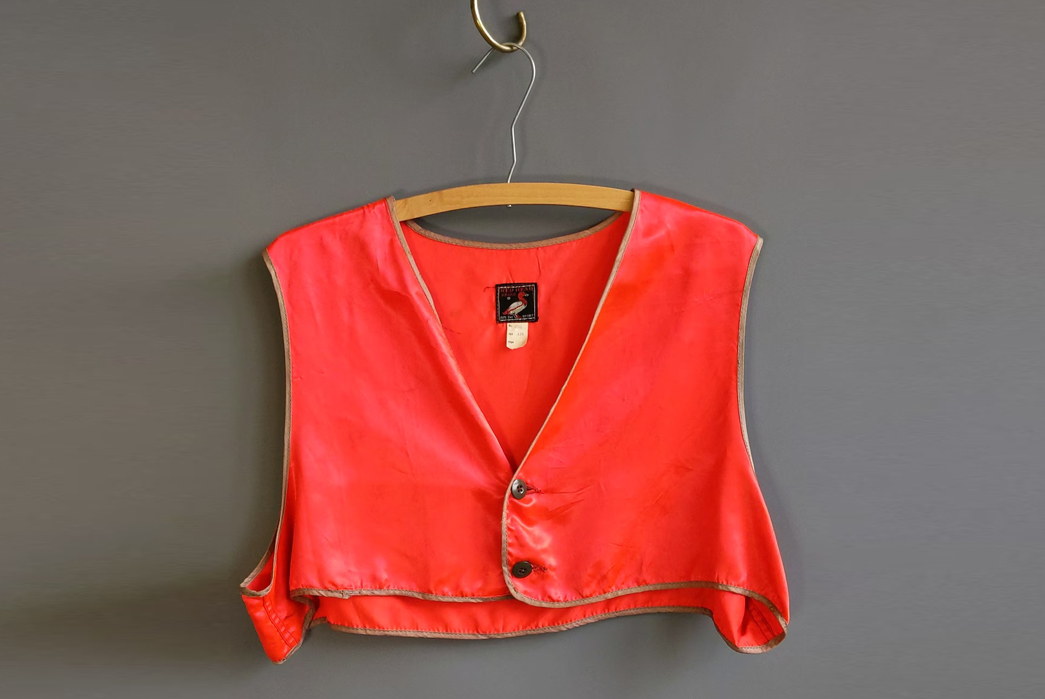
A midcentury DayGlo hunting vest. Image via edgertor/Etsy.
Jack Delano: An Aperture into Workwear Fashion
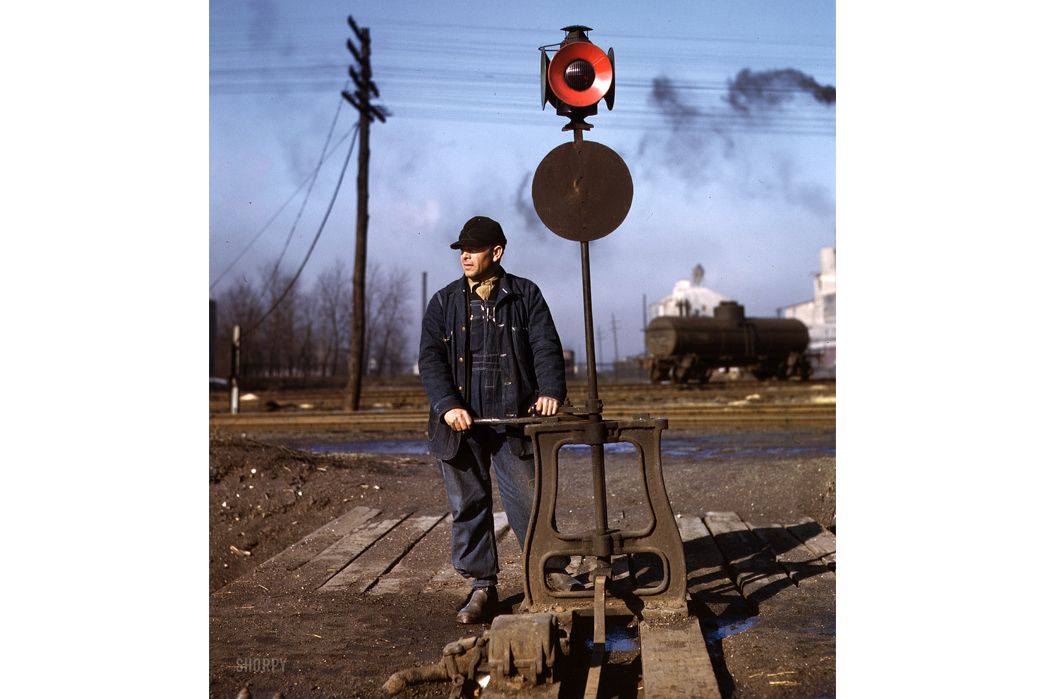
Delano captured albums of images such as this; a switchman named Daniel Senise pictured on the job in February 1943. Image via Jack Delano.
Jack Delano led a life straight from the pages of a screenplay. Born in Ukraine as Jacob Ovcharov, his family came to the United States in the early 1920s where he immediately took to education in fine arts. Delano found work in 1940 with the Farm Security Administration (FSA) as a photographer. He joined the likes of other legendary photographers, such as Dorothea Lange and John Vachon, documenting the many scenes of American working life. Railroads remain at the forefront of his iconic portfolio.
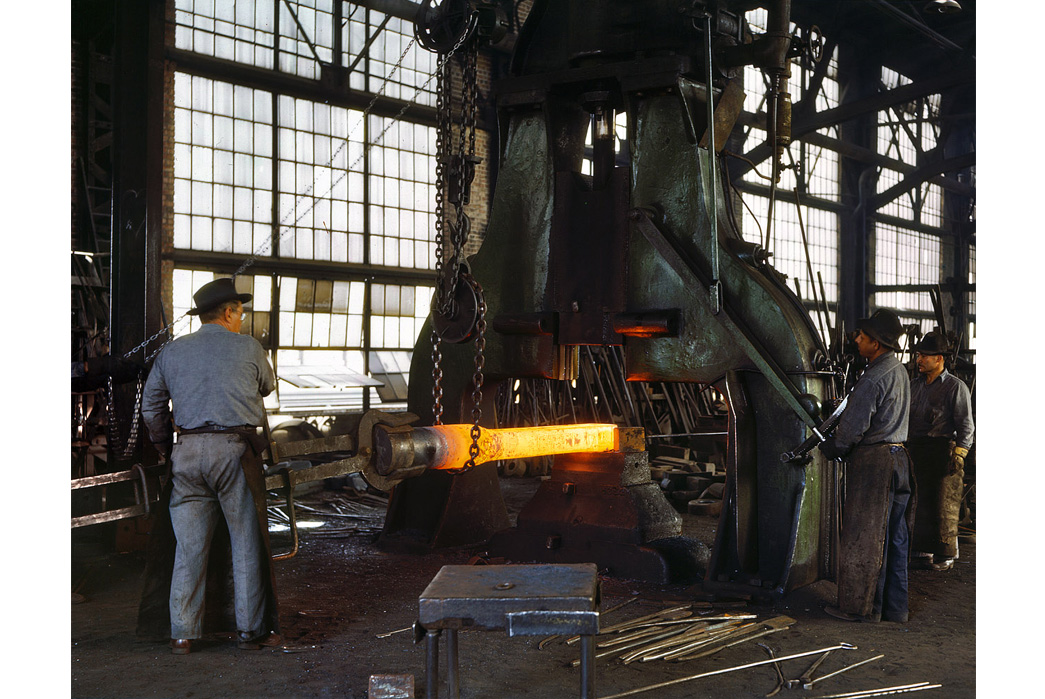
March 1943. Blacksmiths at work in the Albuquerque, New Mexico railroad shops. Image via Jack Delano/Shorpy.com.
The depictions of workwear and material culture that he captured offer an artistic window into the 1940s as dieselization was in its infancy. The FSA’s photography program was cut short at the height of World War II, but Delano’s story didn’t end there. The Office of War Information allowed him to continue his photographic journey in full stride. He went go on to compose music, found a television production company, write poetry, draw cartoons, make movies, teach, and even dabble in architectural design!
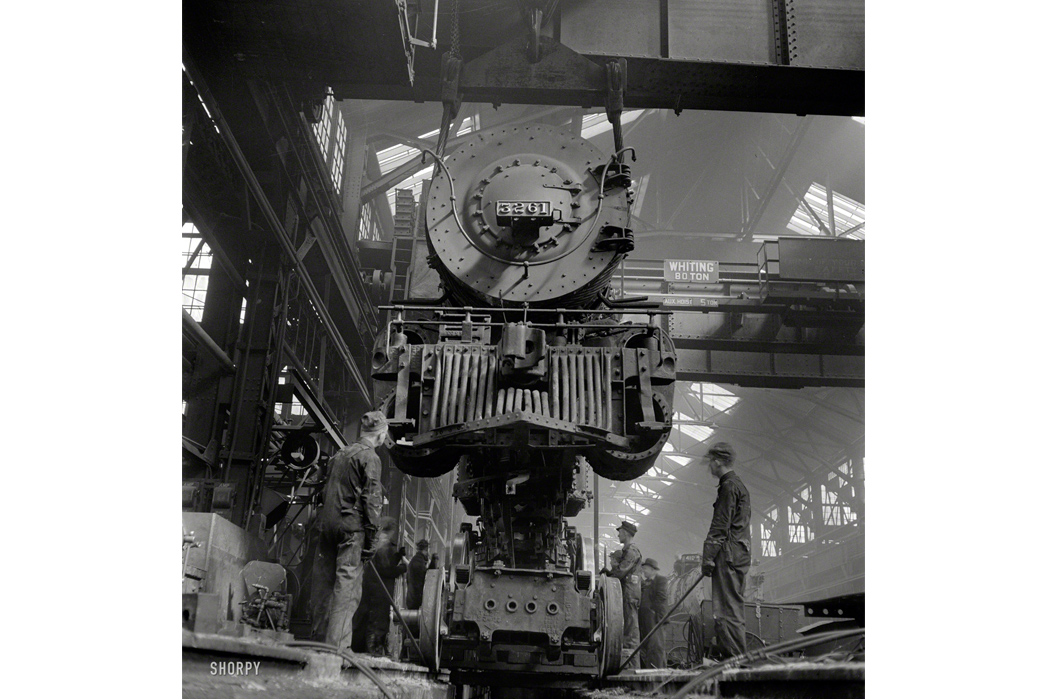
“Shopmen” working on a locomotive in Kansas as captured by Delano from the “pit,” 1943. Image via Jack Delano/Shorpy.com.
Modern Makers of 20th Early 20th Century Railroad Workwear
The railroad styles of the first half of the 20th century remain evergreen. From overalls to coats, this era in workwear inspired many of the early denim revivalists and collectors. It’s not hard to rediscover these styles, reimagined for the modern day if you know where to look and what to look for.
Evil Denim
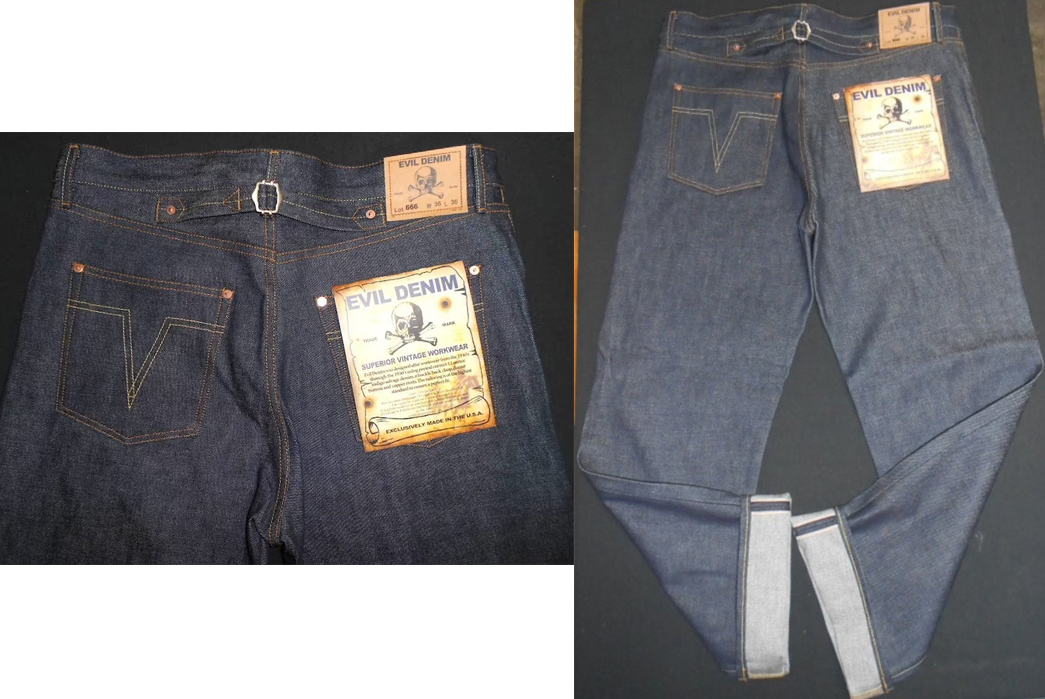
For an iconic buckle-back jeans pattern, look no further. Evil Denim, a small-batch brand based in California, makes clothing inspired by midcentury Hollywood (for truly vintage selections, see the parent store on Etsy: sneakytiki). Whether you’re riding the rails or cruising the highway, the Superior 1930s Reproduction Buckle Back Jeans embody the rugged spirit of the railroads.
Available from sneakytiki on Etsy for $135.
Headlight (Toyo Enterprise)
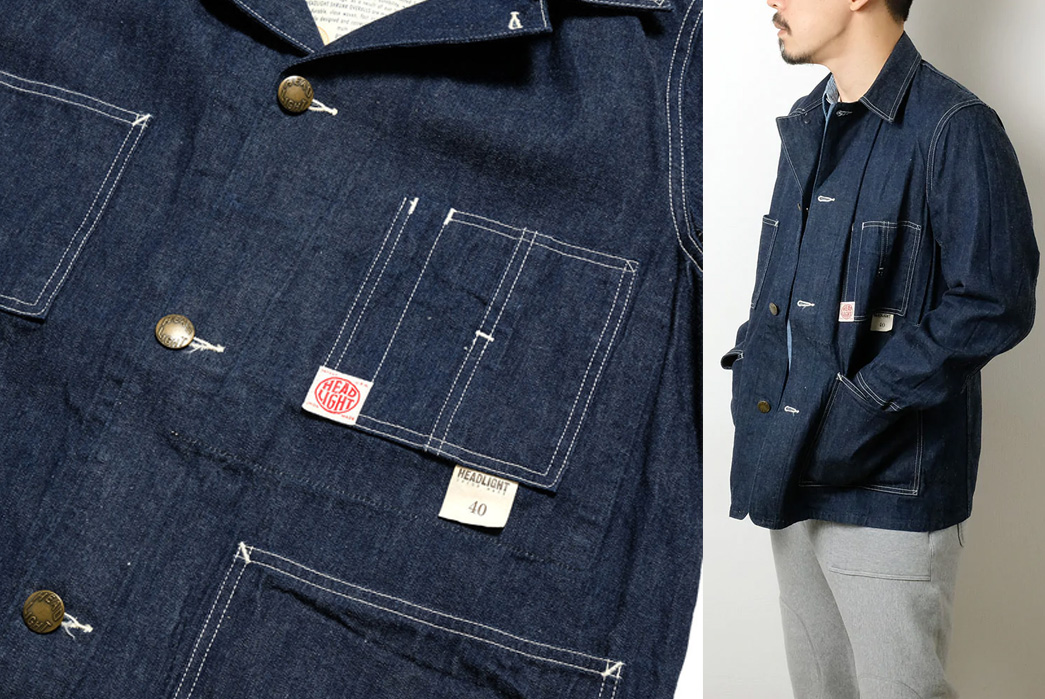
Among other 20th-century workwear and fashion labels, Toyo Enterprise resurrected and acquired the license for the aforementioned Headlight brand. The Japanese powerhouse uses this label to put out reproductions of Headlight’s iconic workwear from the early 20th century.
The 10 oz. Blue Denim Work Coat includes a reference to rationing during World War II, which reduced the number of buttons and changed the construction of the pockets (to eliminate fabric waste). History enthusiasts will appreciate the little details from the types of buttons used to the reproduction of vintage branding. Workwear aficionados the classic 1940s styling.
Available from Hinoya for ~$215.
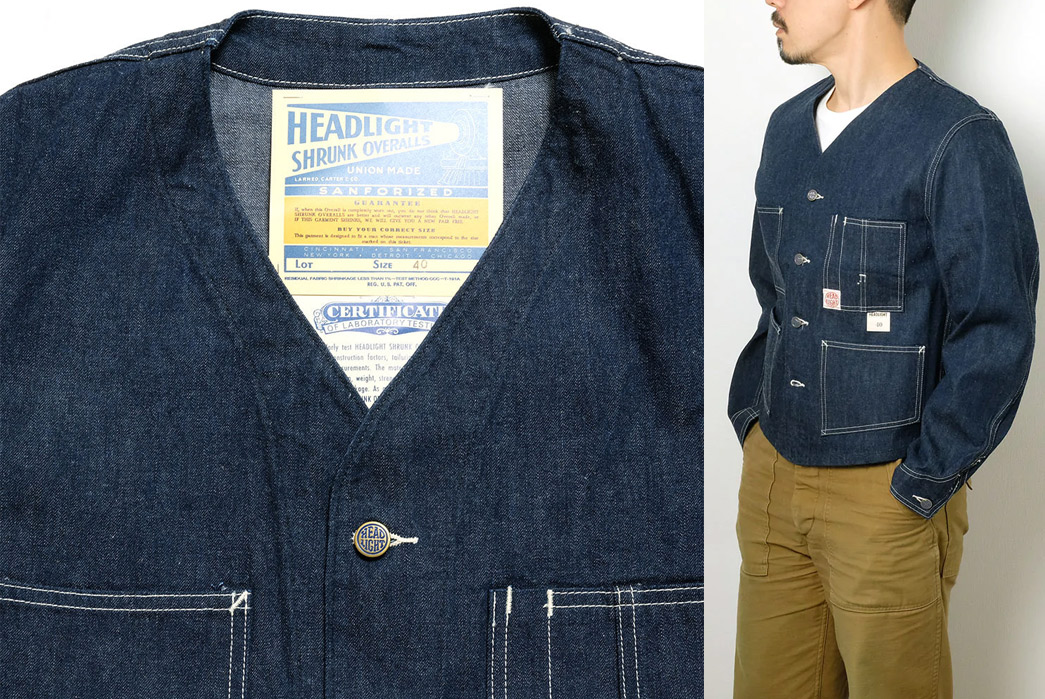
Toyo’s Headlight label also deserves outerwear recognition for their faithful version of a postwar engineer jacket – the 10 oz. Blue Denim Vest (Full Sleeves). Sleek and contemporary, the worker is no longer inhibited by his coat collar.
Available from Hinoya for ~$200
LaRose Hat Co.
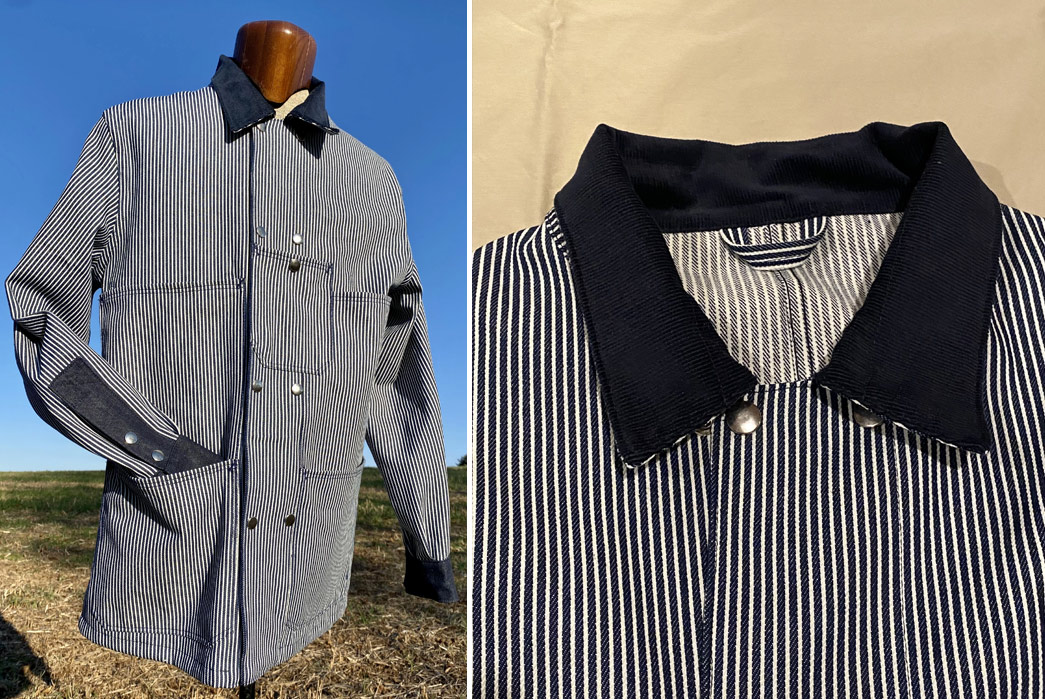
Chris LaRose has carved a niche for discerning railroad enthusiasts. Utilizing the original coat pictured above, he has brought back the distinct stylings of the Thompson Chore Coat for a limited, 50-piece production run. The contrast between raw denim and washed is especially highlighted against the blue-and-white hickory stripes. The indigo corduroy collar, for extra resistance to wear, is also a practical detail.
Available through pre-order inquiry at LaRose Hate Co. for $375.
Lee
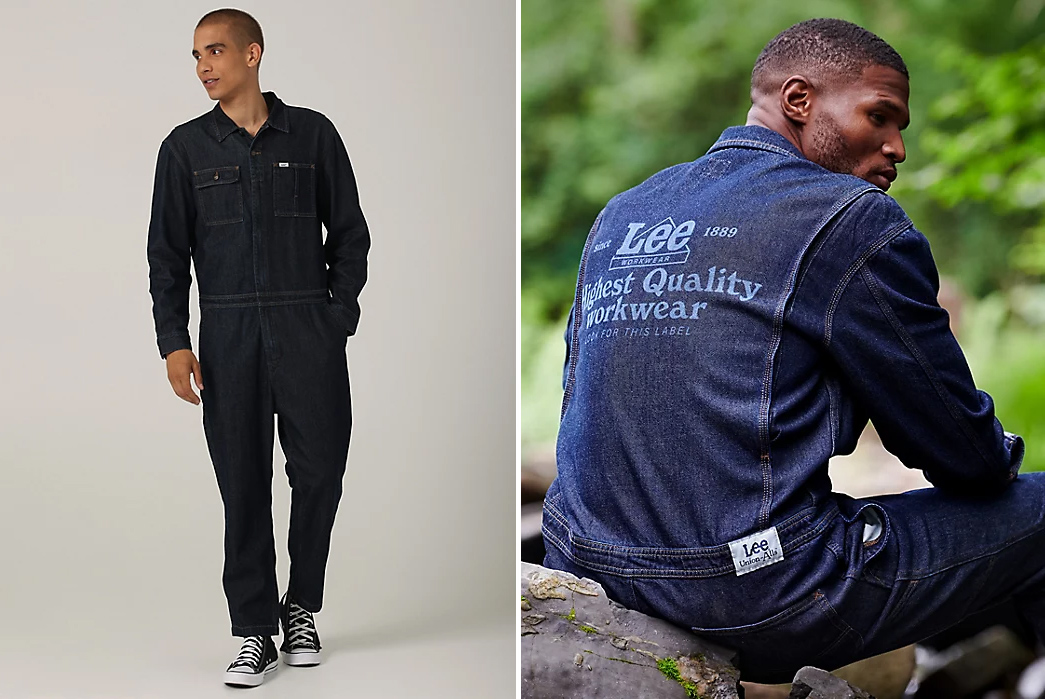
This is a garment that hardly needs an introduction: the Heritage Print Union-Alls in Dark Wash. Since 1913, Lee has draped railroaders in head-to-toe denim. These relaxed-fit coveralls pay tribute with a modern twist; vintage branding is printed on the back.
Available from Lee for $90.
Round House Jeans
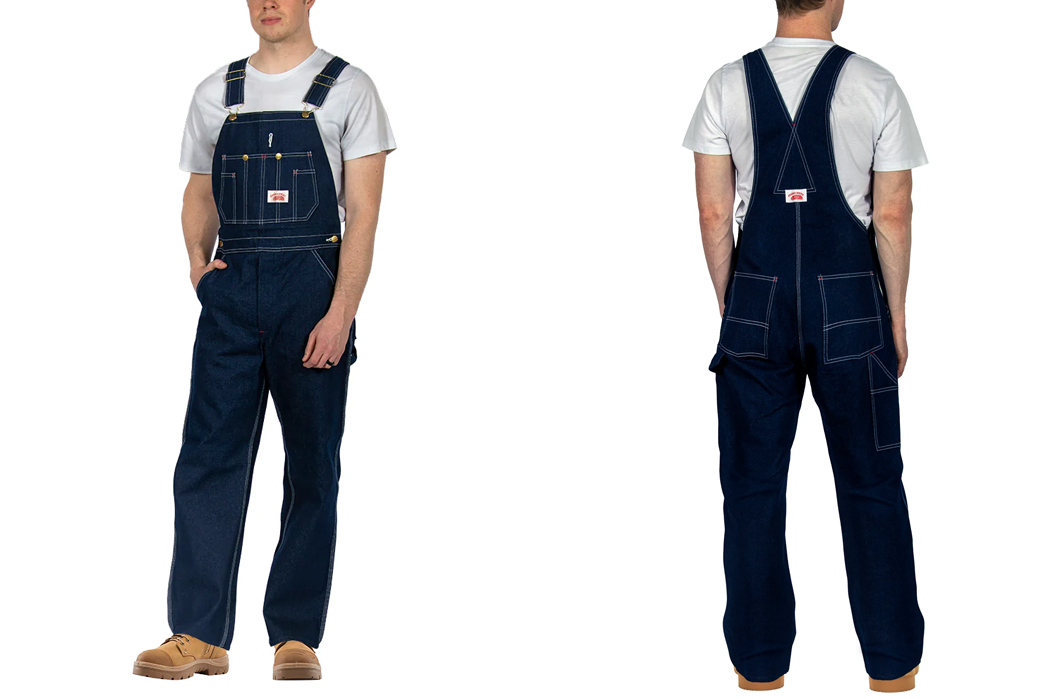
Even the name of this particular brand is a railroad reference, in North America, the “roundhouse” is typically where locomotives are stored and routinely serviced. With an impressive 118-year legacy, Round House is one of a handful of surviving companies that dish out the real deal for history enthusiasts. The #966 Blue Denim Button Fly Overalls embody spartan utility with their construction. Even though Round House has made work clothing over the course of its entire existence, this particular pattern–with its large bib pocket and snaps–harkens back to World War II- and the postwar era.
Available from Round House Outlet for $39.95.
White’s Boots
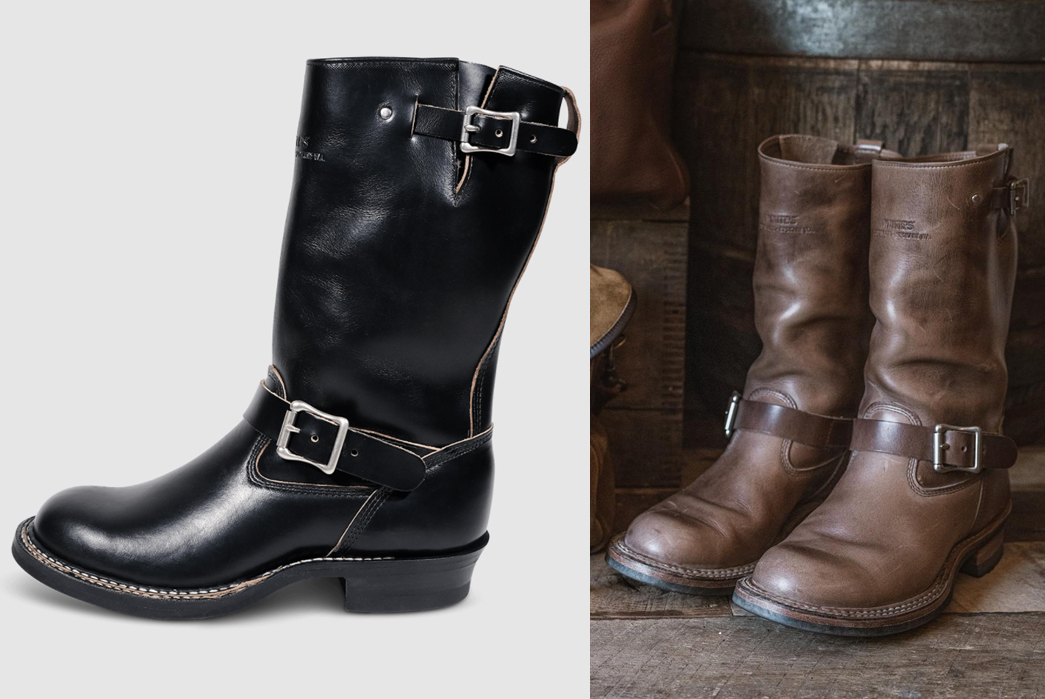
A pair of boots can last a lifetime if properly built. White’s Boots is an O.G. brand that does what few makers have perfected; taking a classic piece of Americana and giving it exceptional detail with a unique and modern touch. Just as boots will last indefinitely when taken care of, this style will remain timeless. The Nomad boot blends modern footwear fashion with classic motorcycling and American railroading.
Available in seven colors from White’s Boots for $700.
Gallery
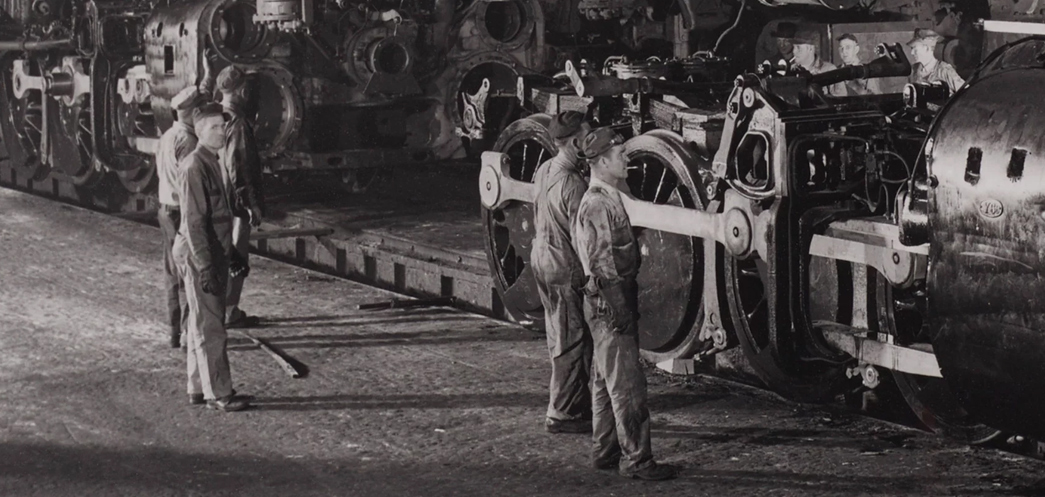
Link photographed this steam locomotive in the final stages of a major overhaul, 1955. This detail, cropped from the original, shows some midcentury railroad fashions. Image via O. Winston Link/Wright Auctions.
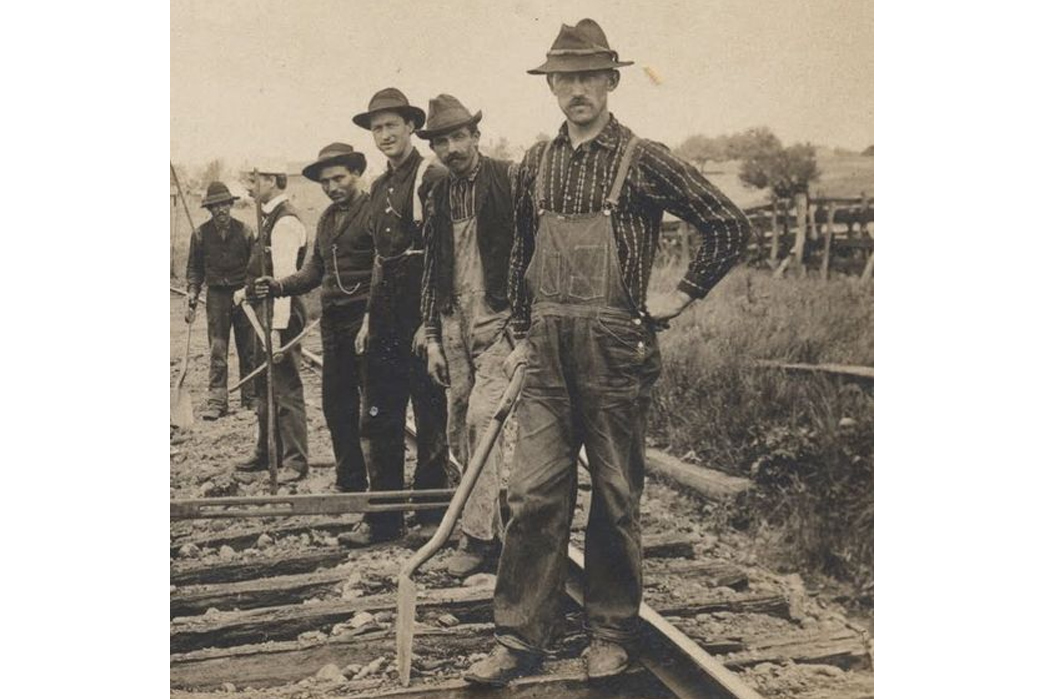
Working on the track in the 1910s or ’20s. Note the diminutive bib pocket on the overalls, front. Several examples of a cotton-print shirt, similar to Wabash stripes, are also visible. Image via rivet_head/Instagram.
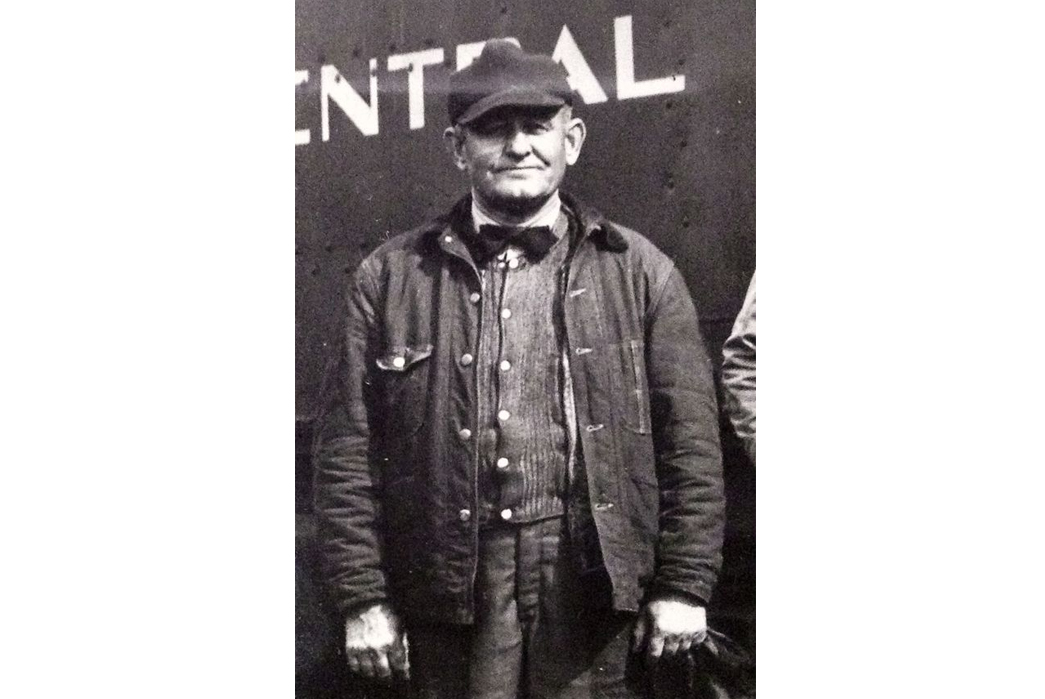
This unidentified photo, likely taken on the New York Central railroad ca. 1940, shows a sharp combination of a collarless vest under a work coat with a trimmed collar. Image via goodandsturdy.com/Pinterest.
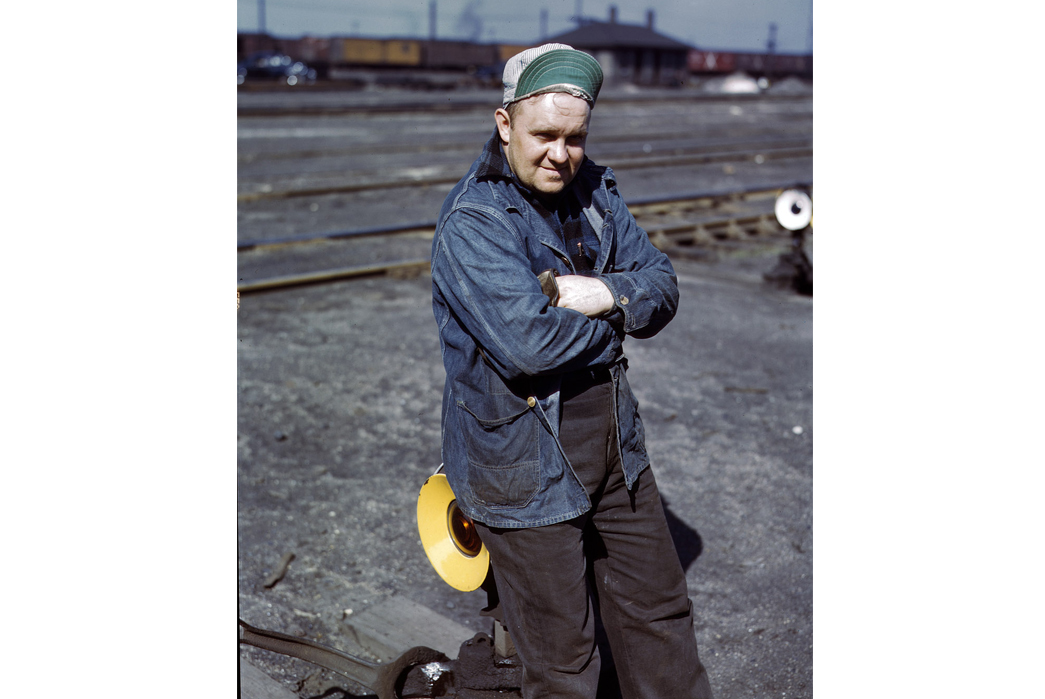
A. S. Gerdee, a switchman, stands for a photo in an Illinois railyard, February 1943. Image via Jack Delano/Shorpy.com.
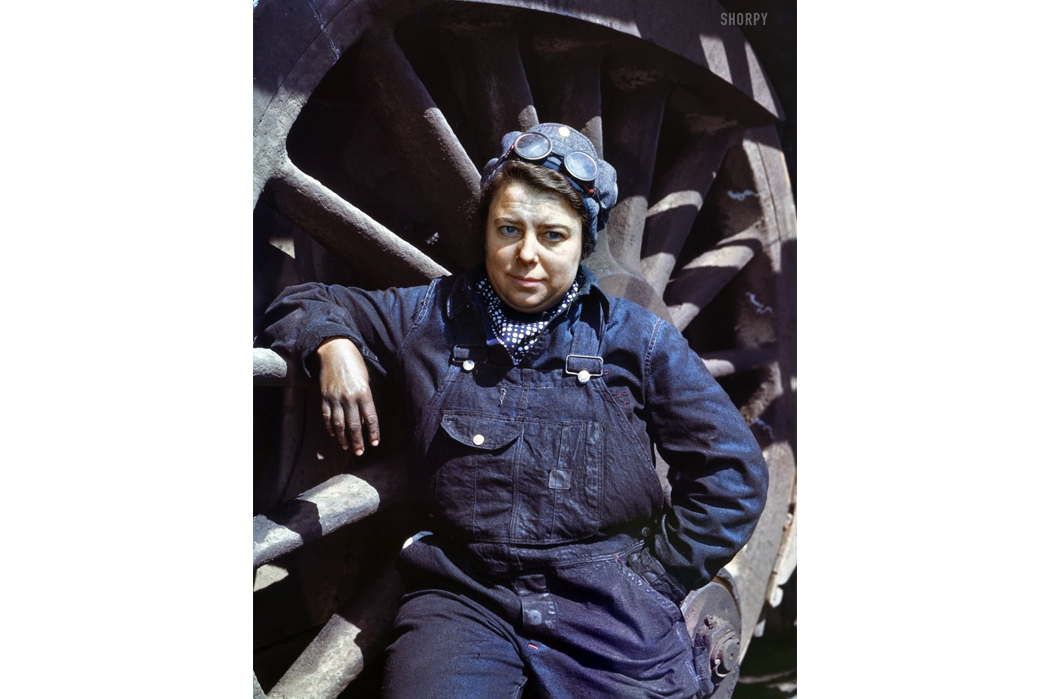
Mrs. Dorothy Lucke, a wiped at a roundhouse in Iowa, pictured in April 1943. Image via Jack Delano/Shorpy.com.
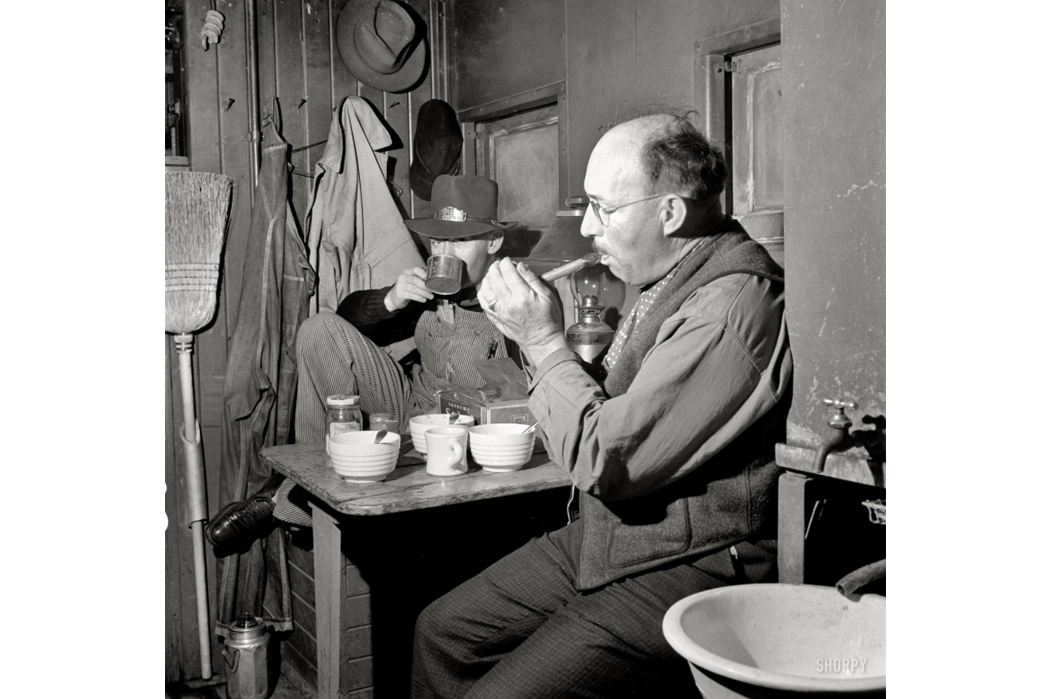
Lunch inside a caboose, March 1943. Note the “BRAKEMAN” hat badge worn by Jack Torbet in the background. Image via Jack Delano/Shorpy.com.
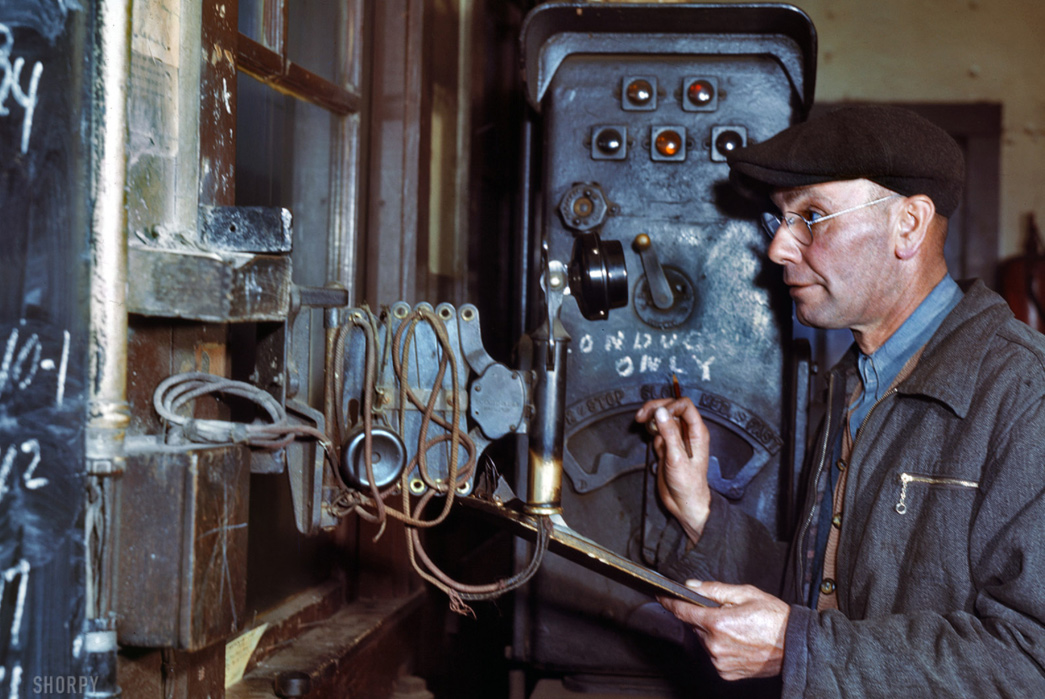
A railyard worker sporting a fine coat with a zipper pocket, 1942. Image via Jack Delano/Shorpy.com.

